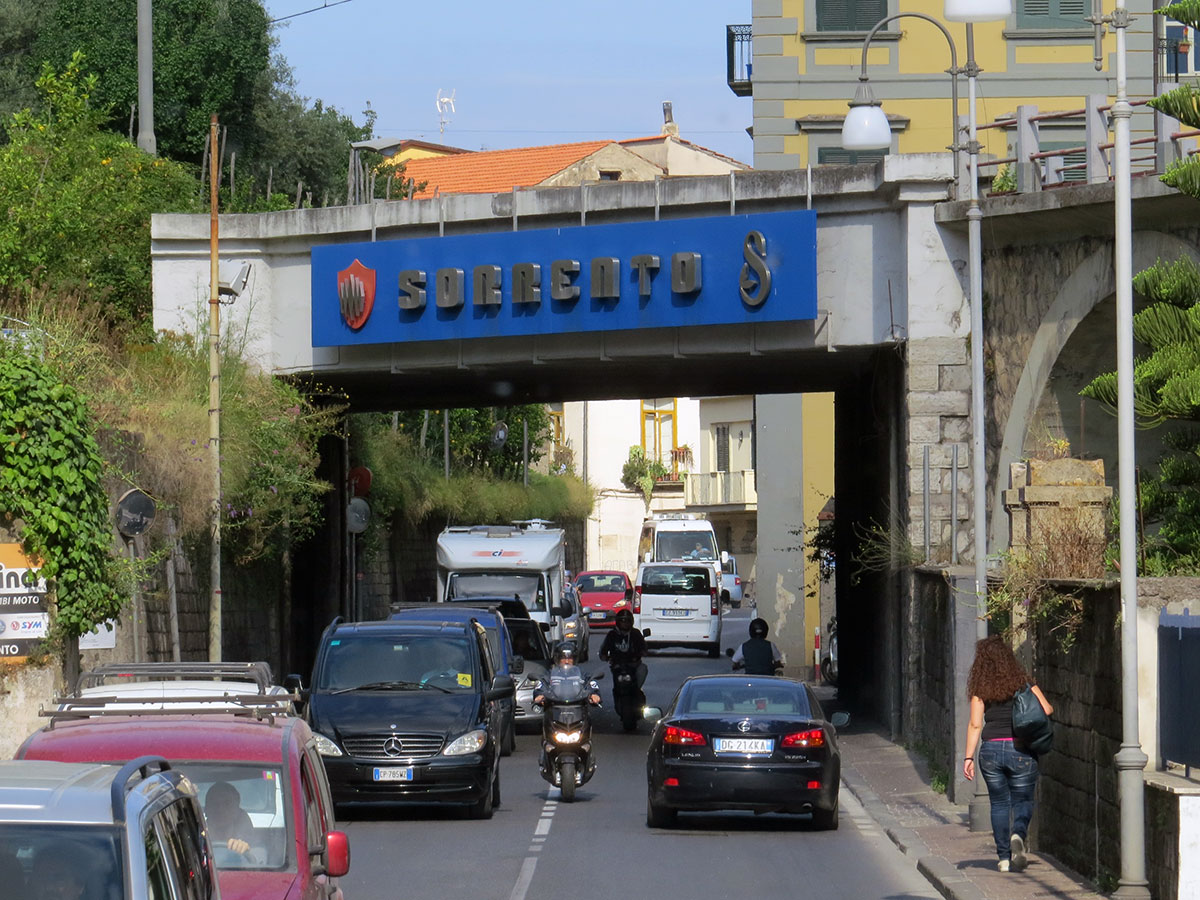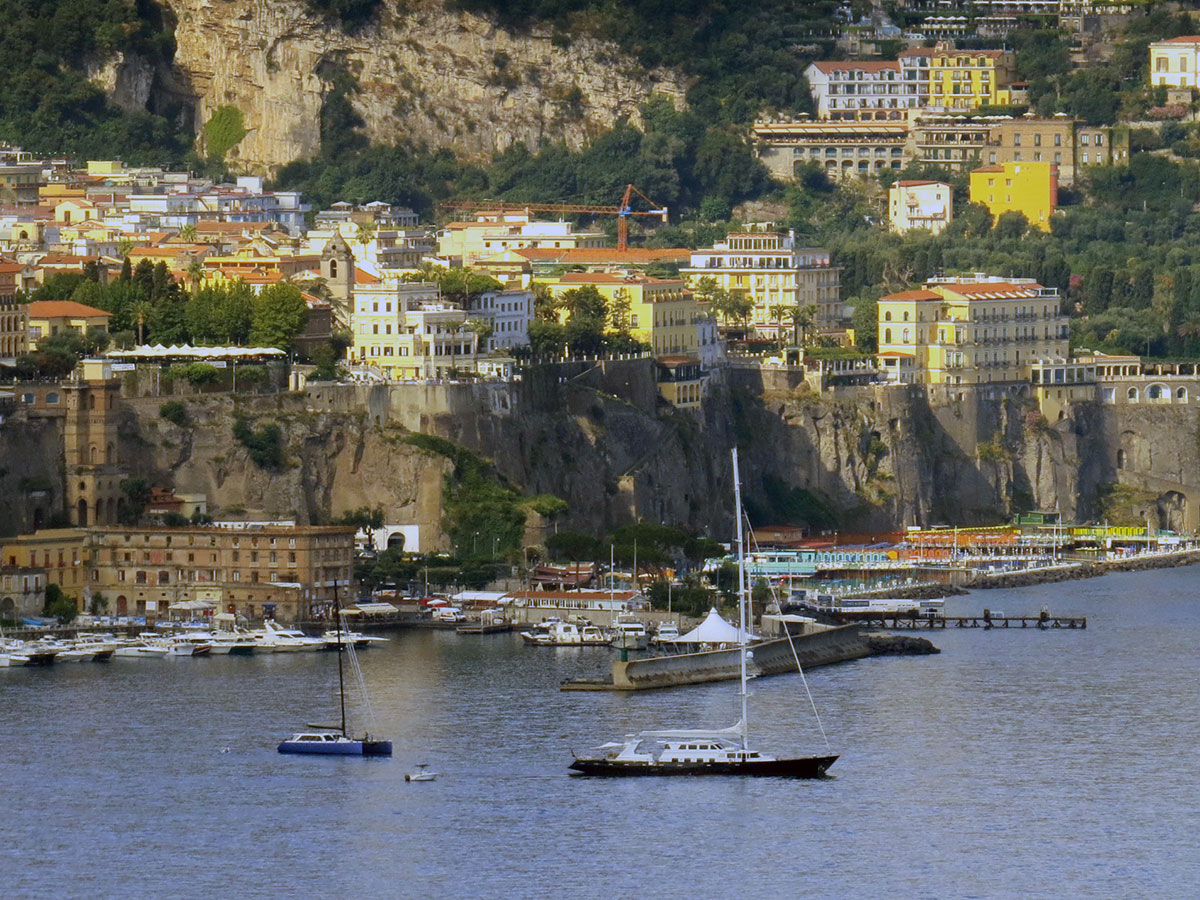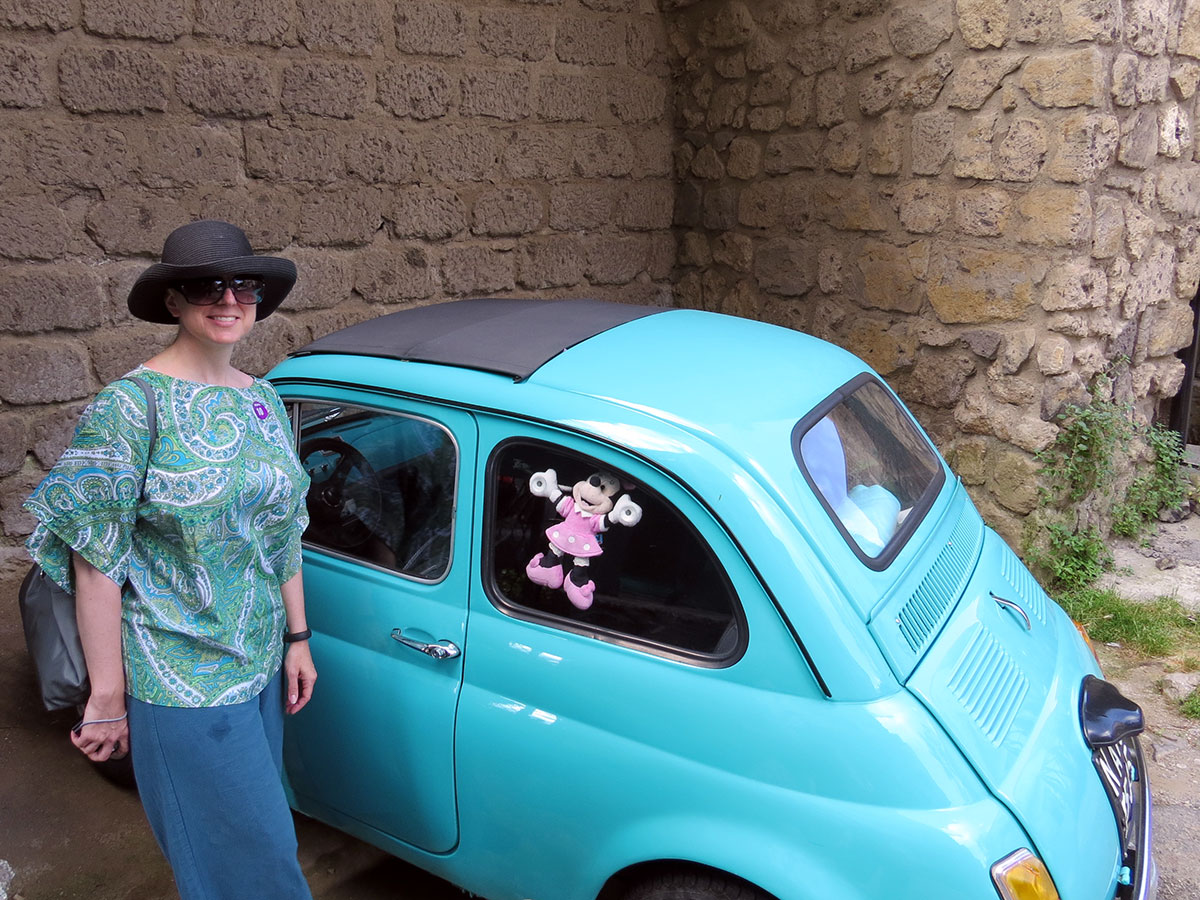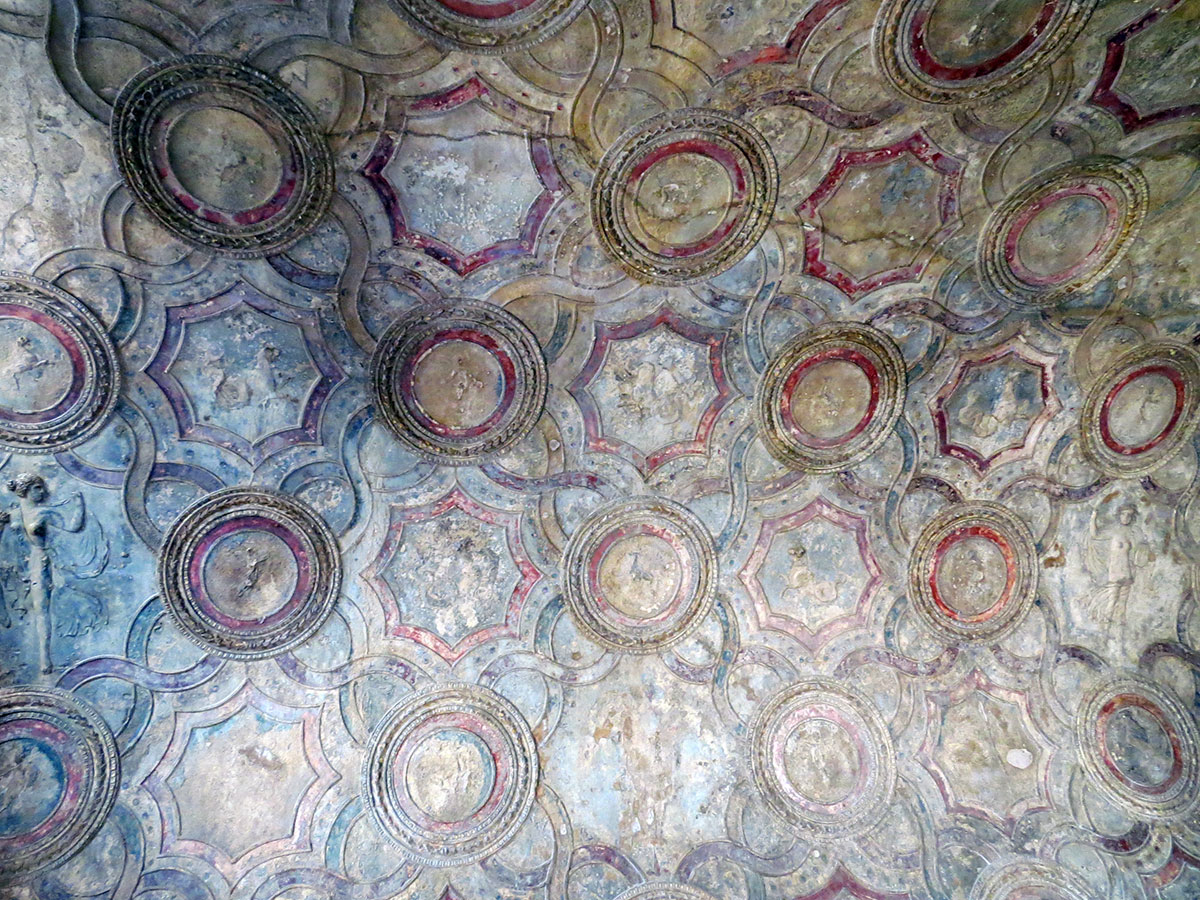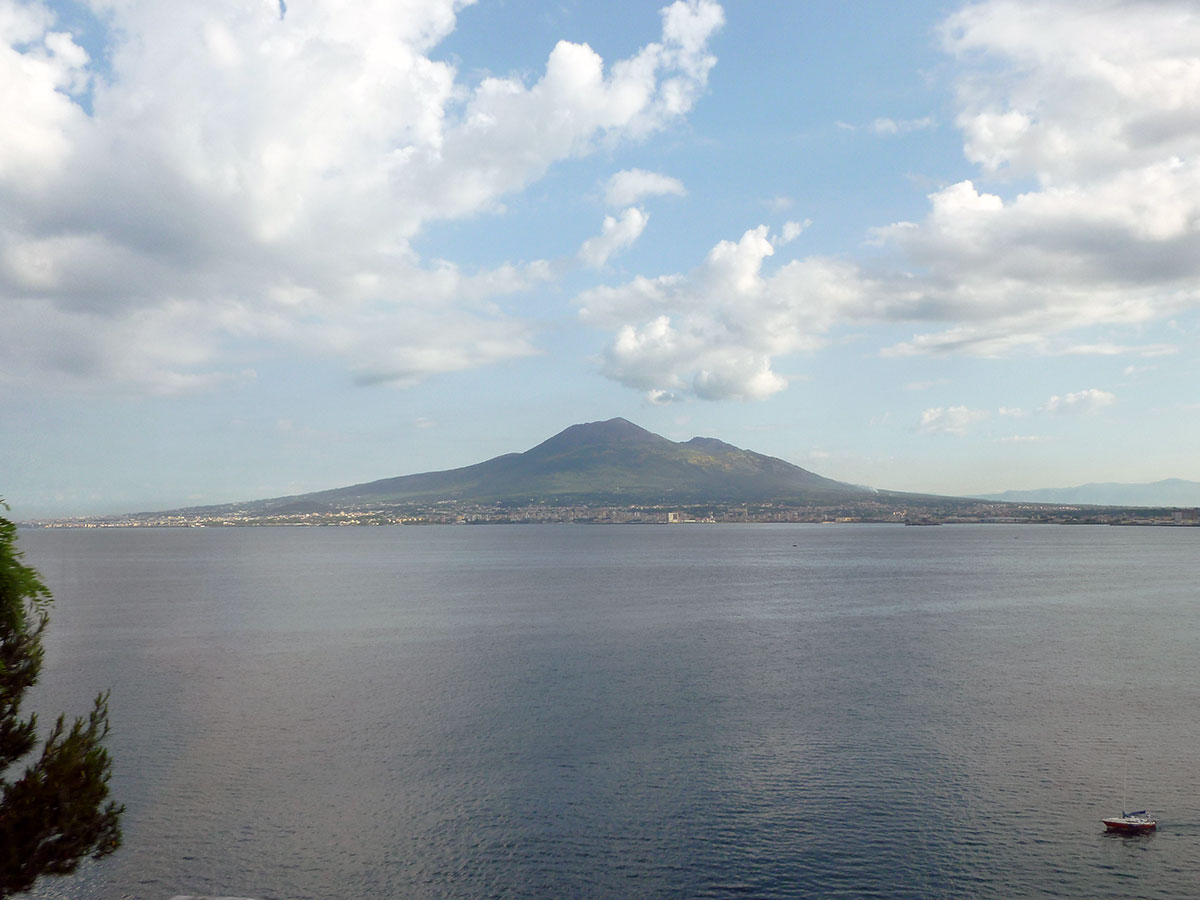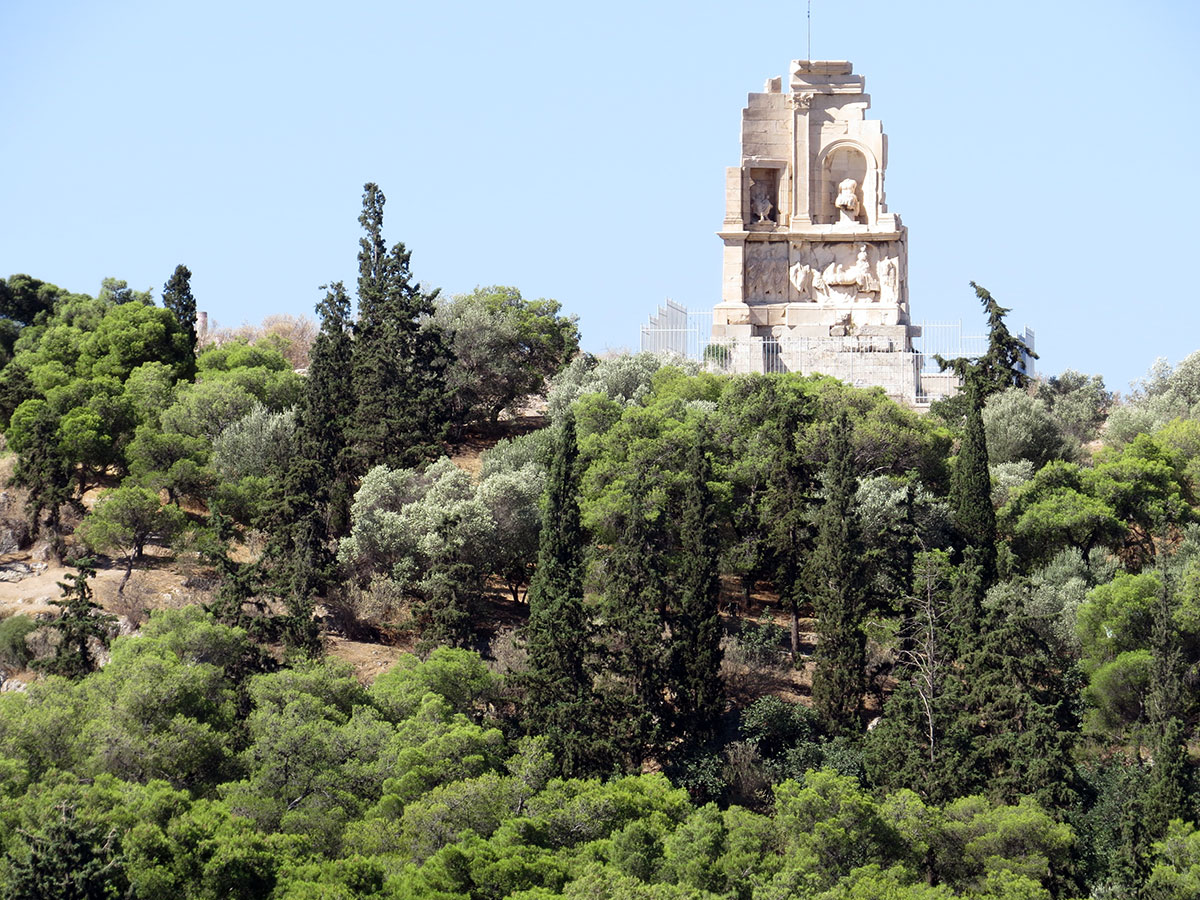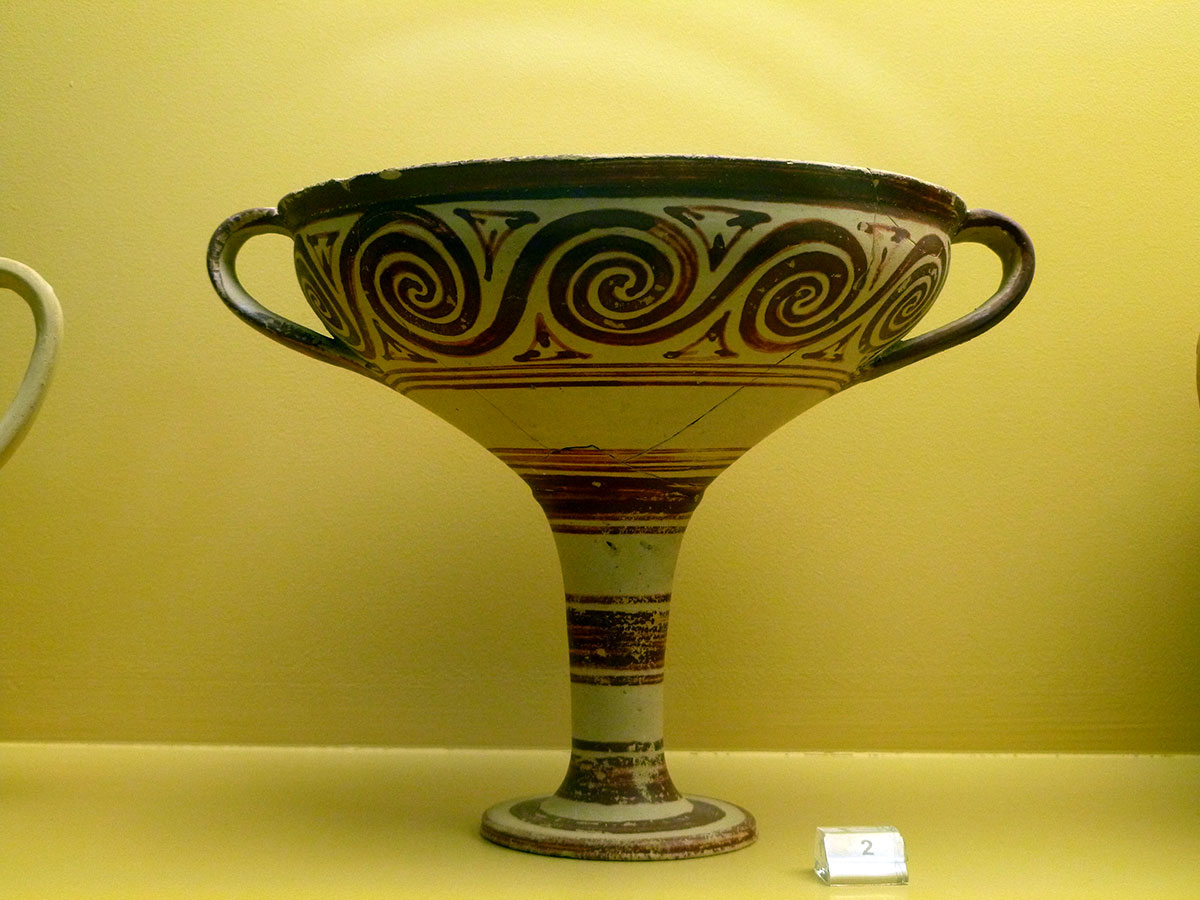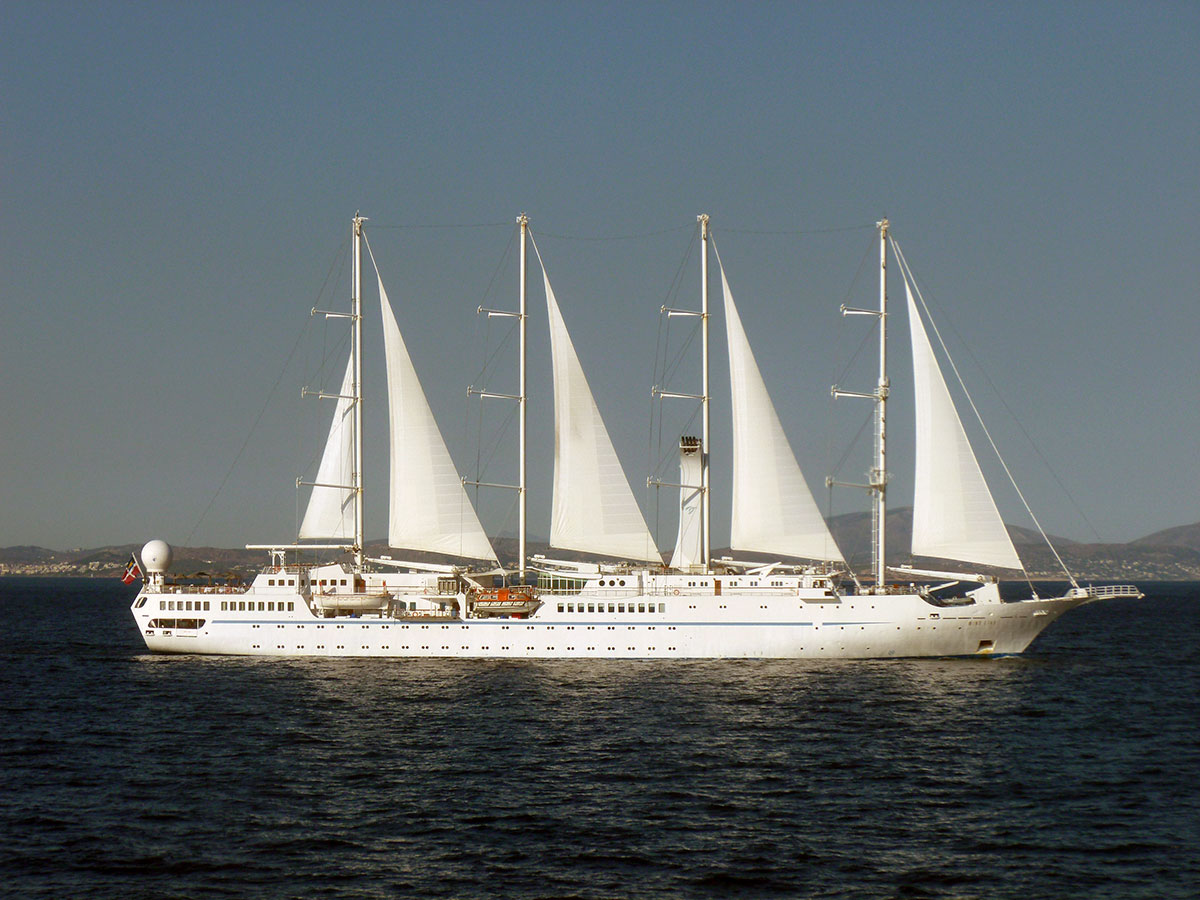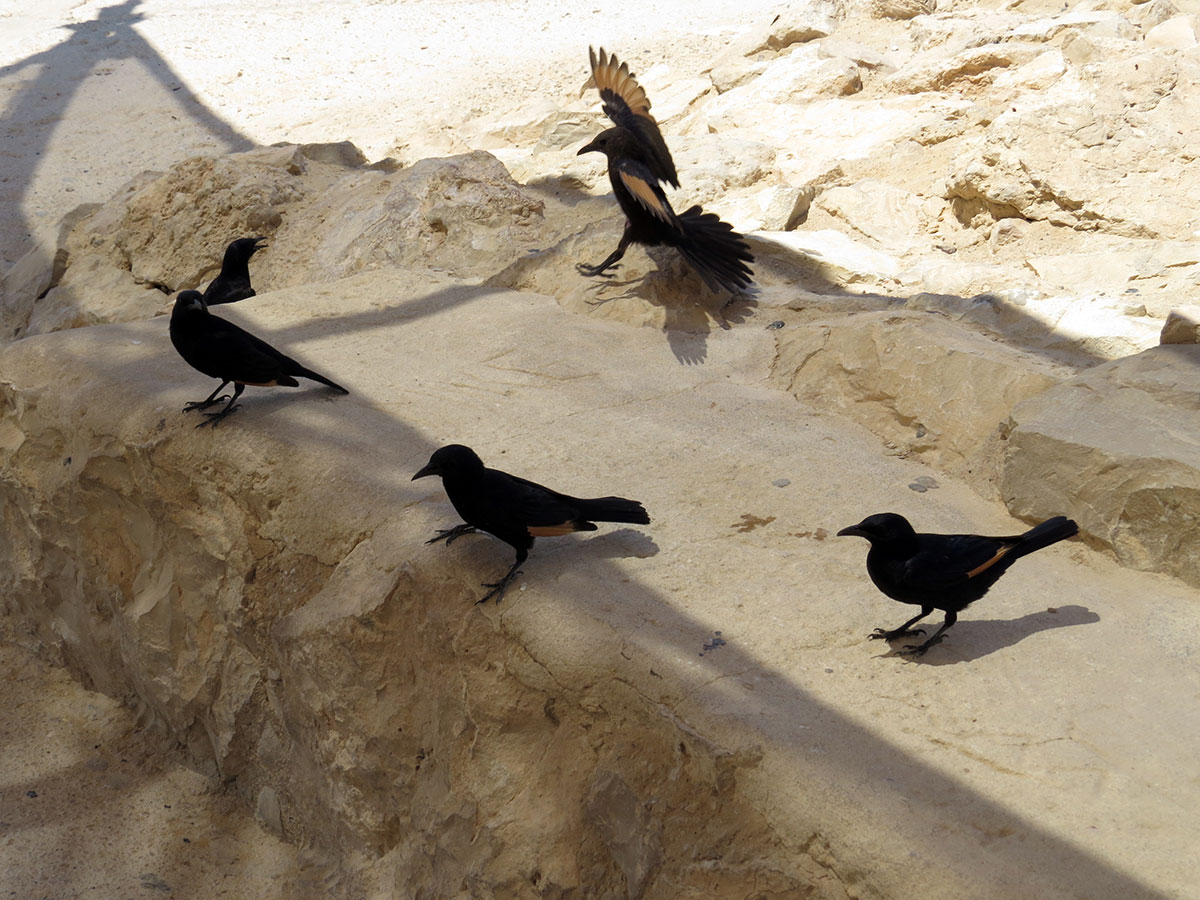Day 048: Atlantic Ocean
Day 047: Atlantic Ocean
Day 047: Atlantic Ocean
Day 046: Lisbon, Portugal
Day 046: Lisbon, Portugal
Day 045: Seville, Spain
Day 045: Seville, Spain
Day 045: Seville (supplemental)
Hi everyone. We’re in Seville, Spain today. Tomorrow is the 4th of July and we should be in Lisbon, Portugal. They probably won’t celebrate the holiday in quite the same way. In the past week we visited three ports in Italy, then Monte Carlo and Barcelona. We have over 1500 pictures from those seven days, so expect some “retro” posts.
Your support keeps us going and we hate not being well connected. We continue to be judicious with the Internet minutes available, balanced with some really sketchy connection issues in the Med. even this morning the speed was much improved after passing through the Gibraltar Strait into the Atlantic. The air even smelled like “home”, a big ocean smell again after the inland seas.
Tour Overview
Departing from Cadiz, you will take a scenic 90-minute non-guided coach ride to Seville, the capital city of Andalusia, and one of the more artistically and culturally significant cities in southern Spain. Along the way, you will see a country side rich with cotton fields and olive groves and pass the historic Tobacco Factory, the setting for Bizet’s Carmen. You’ll arrive within walking distance to Seville’s monumental complex of the Alcazar, the Cathedral de Seville and the Archivo de Indias, the three together forming an UNESCO World Heritage Site. It’s here you’ll start your adventure.
Seville itself is over 2000 years old. It’s the influence of the various civilizations that gives it a distinct personality. In addition to a strong medieval, renaissance and baroque heritage, you can feel, and see the heavy influences from Arabic culture. The Alcazar is a perfect example of the fusions of these cultures. Originally a 913 Moorish fortress this royal palace became a spectacular blend of the Islamic and Spanish Christian architecture. It is still the residence of His Royal Majesty Juan Carlos when he visits Seville. Walk through the various rooms, halls, and patios and you’ll see this unique and unexpected blend of beauty. The spectacular gardens and fountains are definite must-sees as well.
Nearby is the Cathedral de Seville, built on the site of an ancient mosque. This 15th century church is the largest gothic building in the world and the third largest church in Europe. As you enter, you can see works of art abounding, whether it’s the architectural wonders such as the cathedral’s dazzling golden interior, traditional gothic details, or the stunning stained-glass windows, iron screens (rejas) elaborate 15th-century choir stalls, or the works of Goya and other masters.
Adjacent to the cathedral is La Giralda, the 12th century Moorish Tower, and the only remains of the mosque that once stool there. It’s city’s most recognizable landmark. While there are no steps inside, if you are up for climbing the seemingly endless ramp, you will be rewarded with amazing views of the city.
For an example of a quintessential Andalusian palace, visit the Casa Plaza de Pilatos in the Plaza de Pilatos. It was given its present name because the result of its Renaissance/Moorish construction efforts was thought to look like Pontius Pilate’s house in Jerusalem.
To really feel the soul of Seville, be sure to see the picturesque Santa Cruz district for a stroll through its narrow and winding cobblestone streets. El Barrio is deep in the heart of the Seville’s historic center, and was the old Jewish Quarter until the 15th century. Rebuilt to its current glory in the early 19th century, it’s filled with charming tree-shaded plazas, white-washed homes, taverns and cafes. The perfect place to experience life as a Sevillano.
After a full and memorable day, you’ll gather your treasures and meet your motor coach for your scenic return to Cadiz and your ship.
Day 044: Mediterranean Sea (Gibraltar)
Last Port: Barcelona, Spain
Next Port: Cadiz, Spain
Status: Underway
Day 040: Rome, Italy
Day 040: Civitavecchia (for Rome), Italy
Position: N 41º 40′ 00″ E 012º 42′ 00″
Weather: 36ºC wind 10kts, waves 1m
Last Port: Naples, Italy
Next Port: Livorno, Italy
Status: In Port
From the Navigator
We will make our final approach to Civitavecchia at 0545 and will board our local pilot shortly after. Once the pilot is onboard we will proceed in through the breakwater and make our way alongside our berth. We anticipate being all fast by 0700. Once all our departure checks are complete and everyone is back on board we will let go our lines and retrace our courses our of the harbor. Once clear of the harbor we will disembark our pilot and set north westerly courses towards Livorno. We will pass the Island of Giglio on our starboard side at approximately 2230 this evening.
For those who live near us in New England, USA, Rome is at about the same latitude. But the day we were there it was HOT, as if we’d traveled down into the mid-30 degree latitudes. The cooler Mediterranean breezes don’t reach very far inland.

The Coast Guard building for the port of Civitavecchia in Italy. Looks like it is under repair – and needs it.

We arrived on the western side of Rome and within walking distance to St. Peter’s Basilica. It was a Friday and there was not much going on in the square, just tourists.

On this trip we have been watching for survey points. This setup on top of a bridge guard rail looks pretty dangerous. Still, the view is amazing. The water level in the river through Rome was very low and we saw no vessel traffic.

Now this is our kind of book store and the reason you NEED to get away from the tourist corridors. There were some real gems in here including Italian language versions of some ancient Isaac Azimov collections, black and white promotional photos of actors from movies dating back to the 1930’s, a huge collection of 45rpm records and exceptional art and artist books. Sadly our luggage and budget just couldn’t allow more than one book apiece. So, this is a perfect excuse to come back!

Imagine coming out of work at the end of the day, ready for your commute home, to discover this scene. We just happened across these parked motorcycles at some point after a nasty fire completely consumed three bikes and melted two more. Ouch!

Children playing in a public fountain. These public water jets were everywhere, and they were needed by residents and tourists alike.

After a brief stop at a cafe for espresso and cakes we continued our walk into the heart of Rome. Here is a picture of the Parthenon. Our arrival was accompanied by several dozen police and security personnel dressed completely for riot response, a helicopter overhead and paramilitary assault vehicles down several of the side streets.

Soon we understood the reason behind the increased police presence. Apparently the Italian economy is so bad there is a regular labor demonstration on Friday, every Friday. The locals turn out to enjoy the spectacle.

This inlaid wood pattern was part of the ceiling at Domiziano, the restaurant where we had an excellent lunch of spicy penne pasta, red wine and local dark grain bread flavored with sage and topped with melted mozzarella cheese.

Walking by this scene we were disappointed to have already eaten. Every little open doorway invited us in for another potential experience – the REAL ROME.

Above these doorways and too the right is the wall separating Rome from Vatican City. We had just passed out through a large archway in the city wall. What are the faces and hands guarding, we wonder?
Tour Overview
A short private shuttle ride from port takes you to your private train car. Embark on a classic adventure as you ride in comfort through the Italian countryside and across the Etruscan Region.
You’ll arrive at St. Peter’s Station 60 minutes later, and a tour escort will show you the designated meeting place. The 6.5 hours are all yours in the most magnificent city in the world.
Discover independently the magnificent St. Peter’s Square that features a central obelisk, refreshing twin fountains and semicircular colonnades crowned with statues of the saints designed by Bernini. This striking piazza frames the entrance to St. Peter’s Basilica, which you will have time to explore- or just browse the square’s shops at your leisure. You’ll feel like a local as you wander through the bustling city streets, sampling local cuisine and perusing the boutiques. Sip a cappuccino at a trattoria or savor a refreshing gelato from a street vendor before shopping for souvenirs and exquisite leather goods. Photo opportunities abound, and around every corner you’ll find such historic monuments as The Roman Forum, the Colosseum and the Arch of Constantine – many within close proximity to each other. City maps will be provided on the train and local transportation in Rome is readily available.
A wonderful way to maximize your day in Rome is to utilize the hop on & hop off bus system. This upgrade can be purchased on the private train to Rome, depending to local conditions. The bus route stops at the main archaeological sites and historical landmarks. The buses run continuously arriving at each stop about every 20 to 30 minutes.
Remember, you will need local currency for attractions, meals and shopping. Plan to exchange your money onboard the ship or at a currency exchange in Rome.
Return to your escort at a designated place and time to meet your train for a relaxing ride back to port. Views of the imposing St. Peter’s dome offer a fond farewell as you leave the Eternal City but bring its memories home.
Day 039: Naples, Italy
Day 039: Naples, Italy
Position: N 40º 50′ 36″ E 014º 15′ 46″
Weather: 29ºC wind 12kts, waves 1m
Last Port: Istanbul, Turkey
Next Port: Civitavecchia, Italy
Status: In Port
From the Navigator
Throughout the early morning we will maintain a north easterly course along the Tyrrhenian Sea towards Naples. At around 0445 this morning we will pass between the island of Capri on our port side and Sorrento on our starboard side as we make our approach to Naples. We anticipate boarding our local pilot at 0600 before entering the harbor through the breakwater and maneuvering alongside our berth. We expect to be all fast alongside at 0700. This evening once everyone I’d back onboard we will thrust off our berth and retrace our courses out of the breakwater. We will disembark our pilot and set north westerly courses paralleling the coast of Italy towards Civitavecchia.
Today was busy with a multifaceted trip, first to Sorrento, Italy for lunch and shopping, a tour of a lemon, cheese and olive farm, then to Pompeii to tour the excavated remains of the ancient city destroyed by Mount Vesuvius. Along the way we picked up some new Italian words and restocked our supply of local fresh fruit. There is a decidedly “southern European” feel to this place – very Mediterranean, resort-y and relaxed.

The route to town snakes along the steep, south-facing cliffs. Eyes on the road and don’t look down.
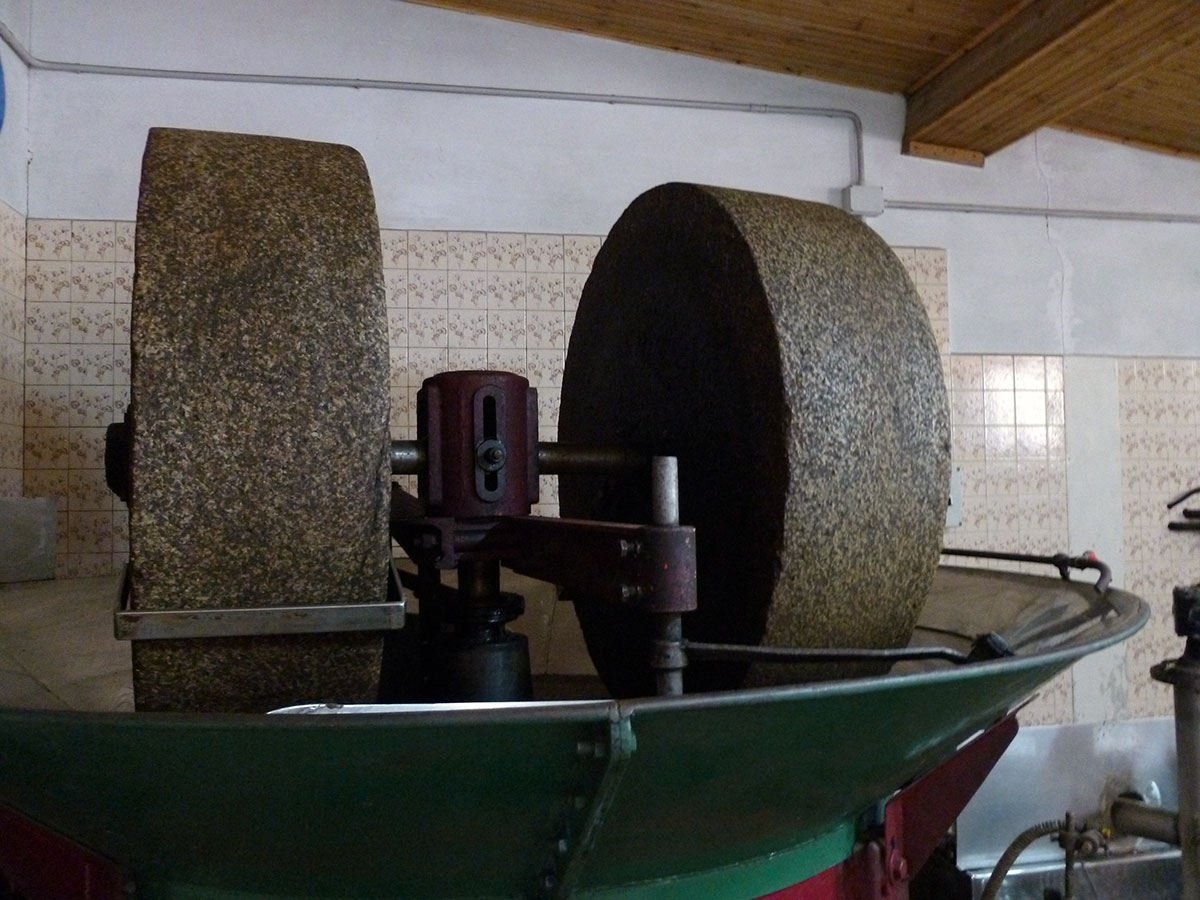
These one meter diameter stone wheels have been crushing olives into oil for over 100 years. They were once turned by donkey power and today by an electric motor.
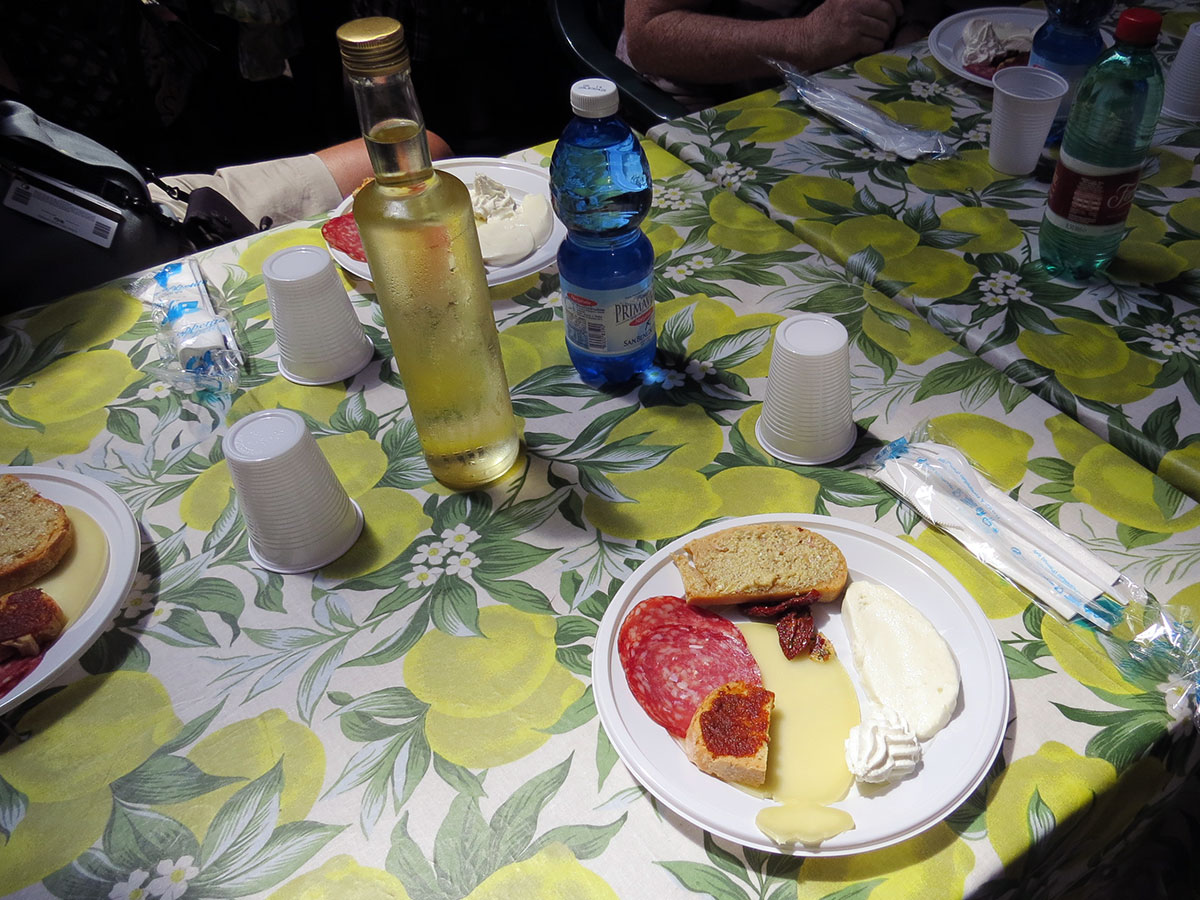
A little slice of heaven. Everything you see on the plate was grown and produced within 100 meters of the table. We sampled four types of cheeses, two different breads, local olive oil, white wine and several types of limoncello.
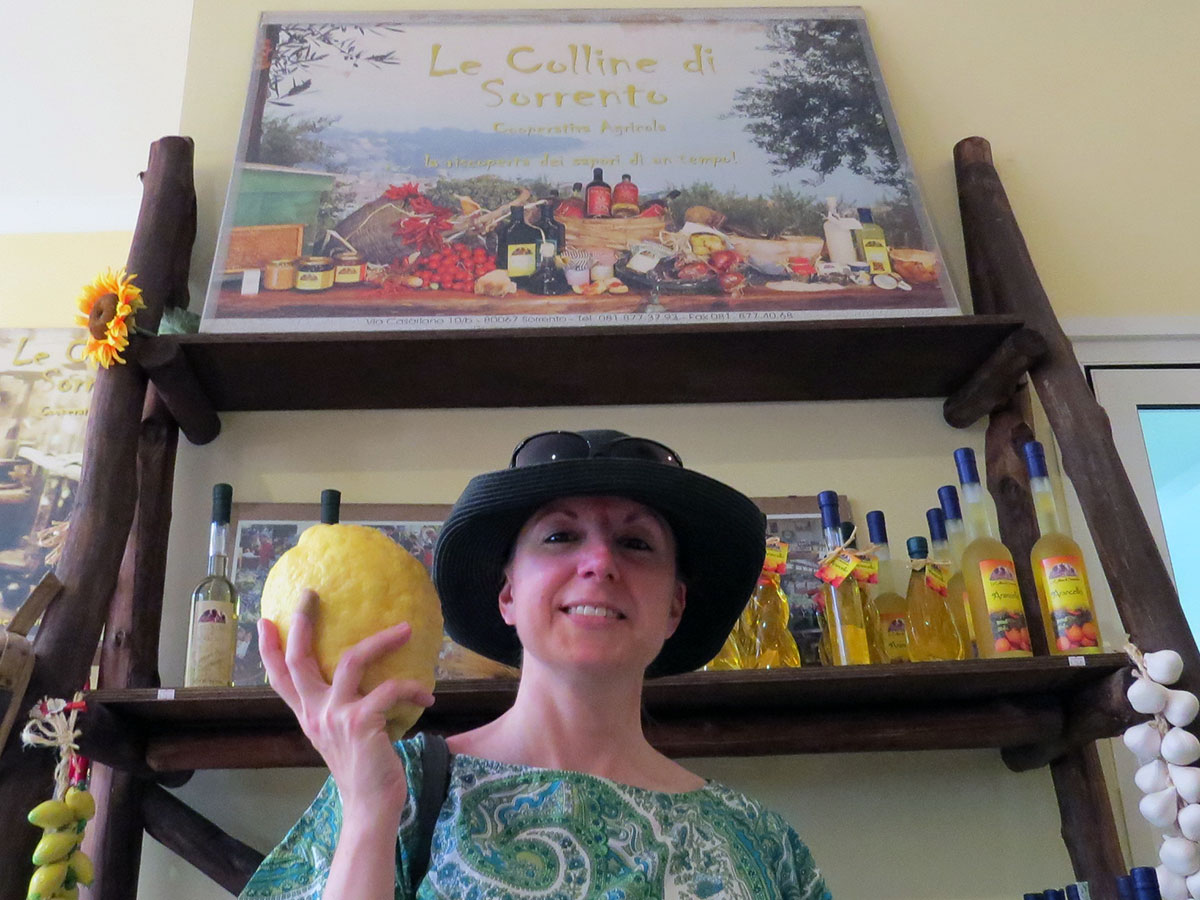
Now that’s a lemon, and not even the largest one in the basket. Each fruit could probably produce an entire glass of lemonade.
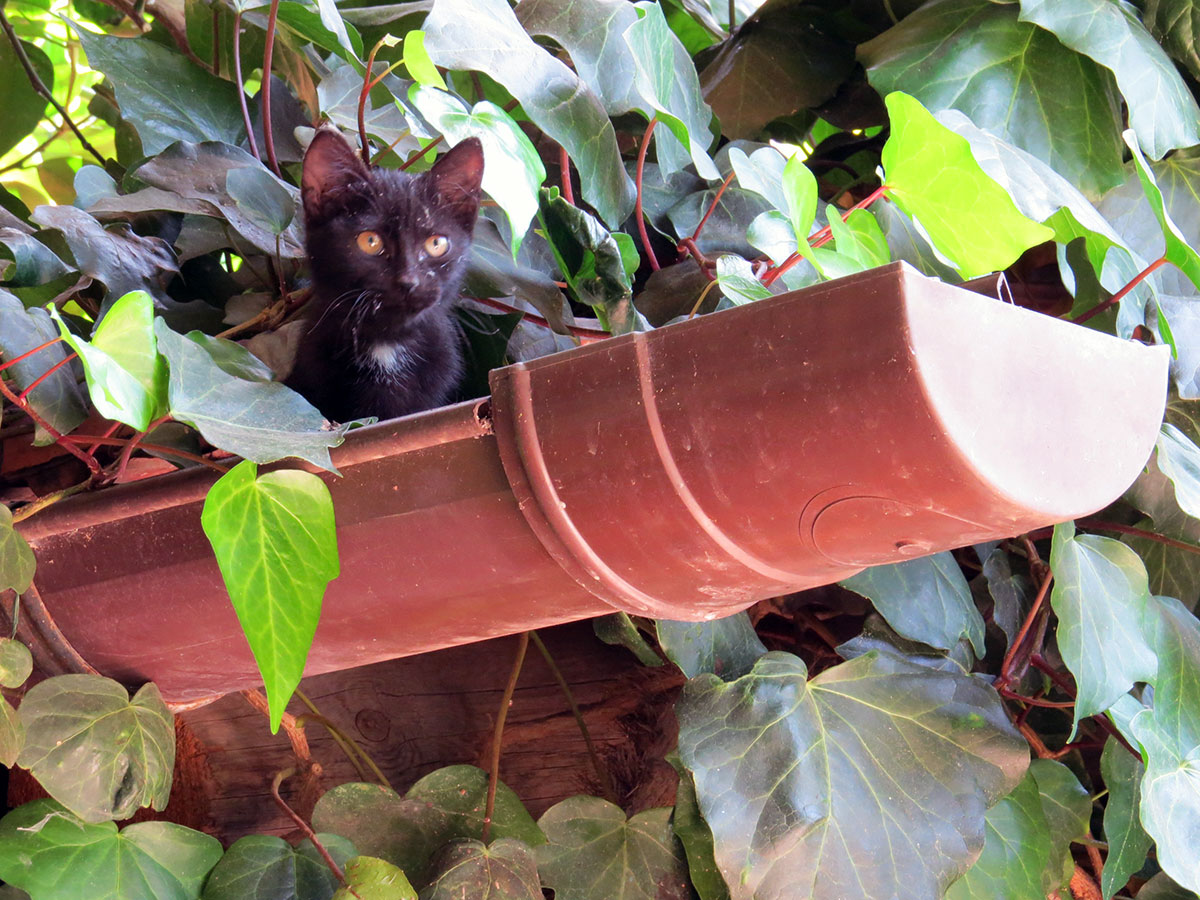
This drainspout kitteh was very vocal when we were paying her some attention. Probably begging for some of the exceptional local salami or cheese.

This is a plaster cast of the cavity left by an unfortunate inhabitant of Pompeii. Several such casts were on display. They were quick to point out the casts were NOT human remains. Still, the detail preserved by the ash and lava is striking.
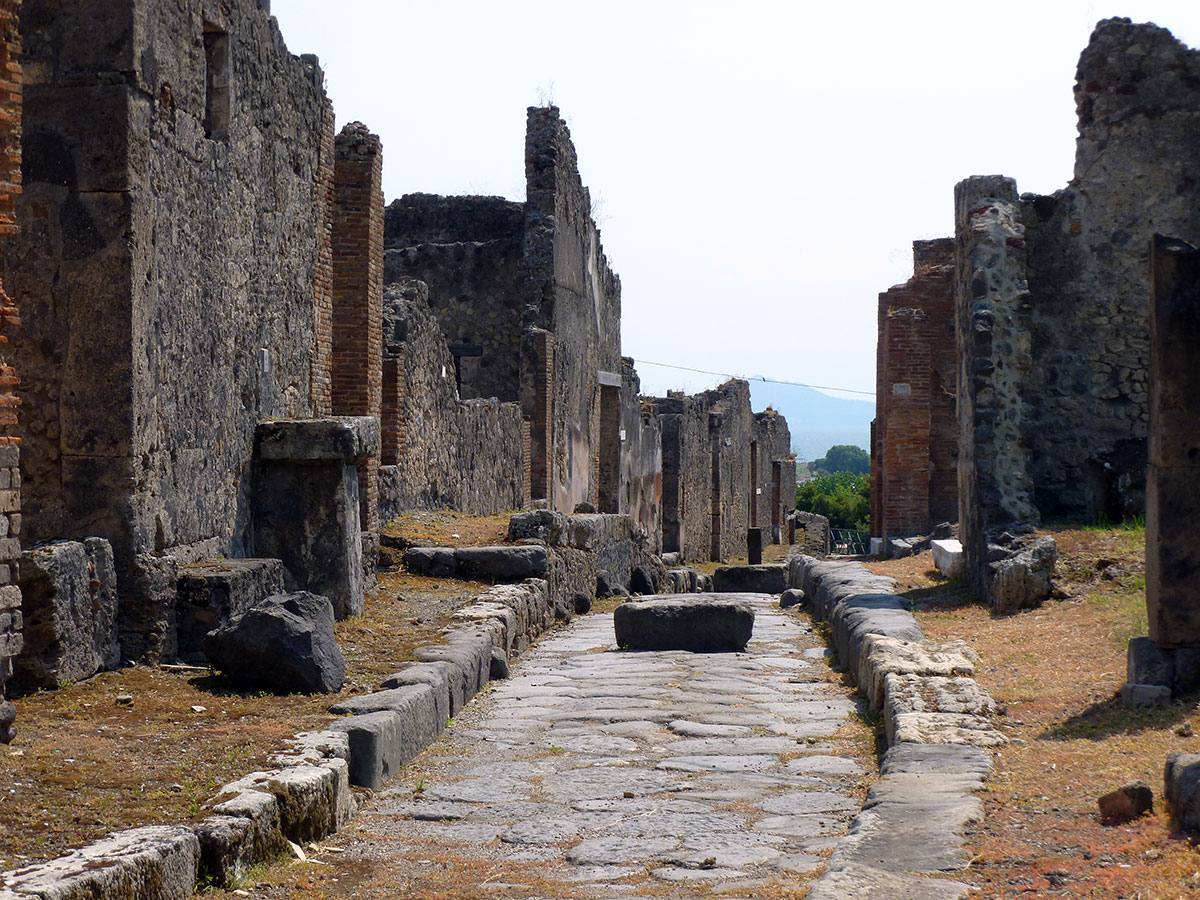
A typical street in ancient Pompeii. This picture tells many stories. First, you have to keep in mind that everything you see had to be uncovered by excavators. Then you realize that this is one of hundreds of streets already uncovered. The large stone you see in the middle of the street is not a security barrier or something that just fell there. It’s a crosswalk. With horses, mud and household garbage all mingling together in the roadway such stones were how people kept their feet clean while crossing the street.

Take yourself back 2,000 years and imagine yourself walking to work. You are about to pass through this archway, as you’ve done every day for your entire life, when suddenly the mountain in front of you erupts with pyroclastic fury. Within minutes you realize there is no escape as the ashes begin to fall around you.
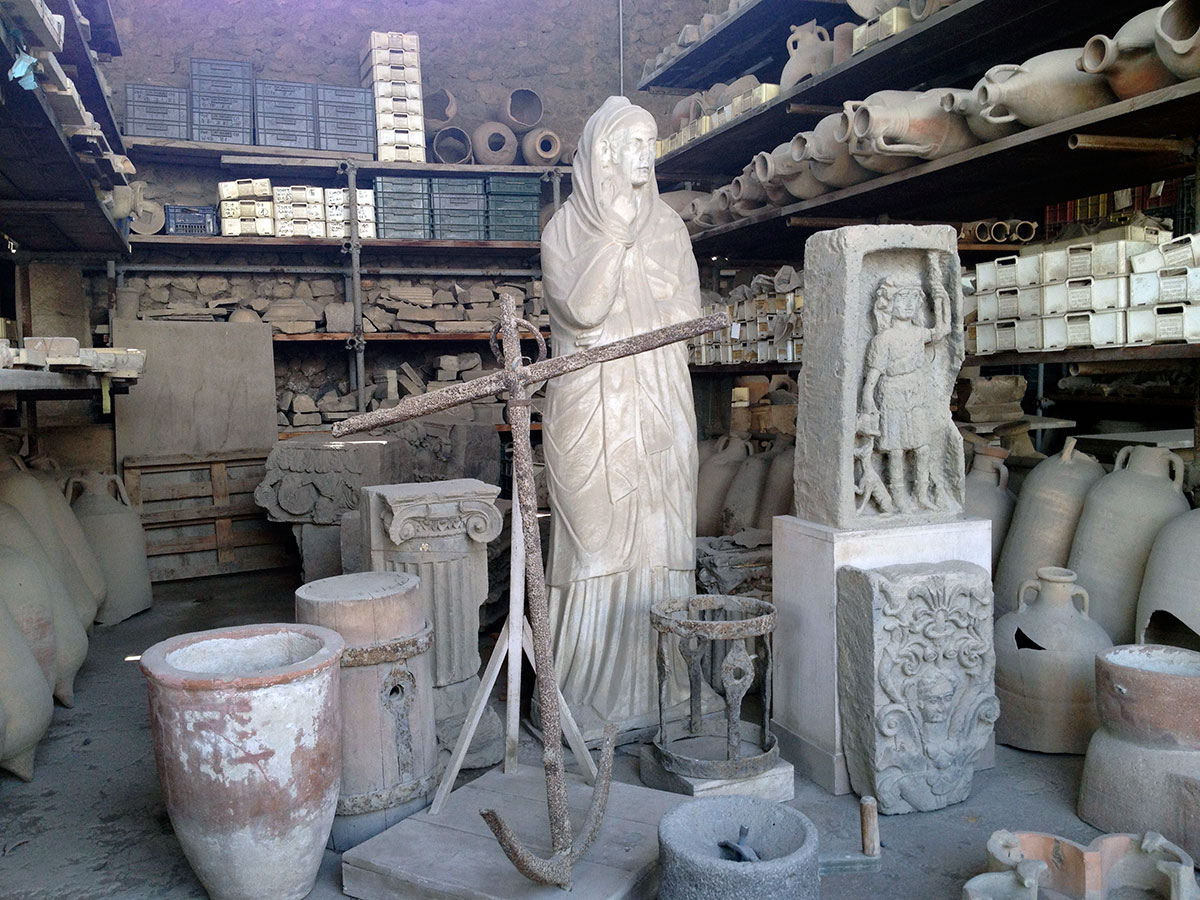
Artifacts extracted from the excavation of ancient Pompeii. The cages of perfectly preserved objects go on and on. The century-old project continues to this day.
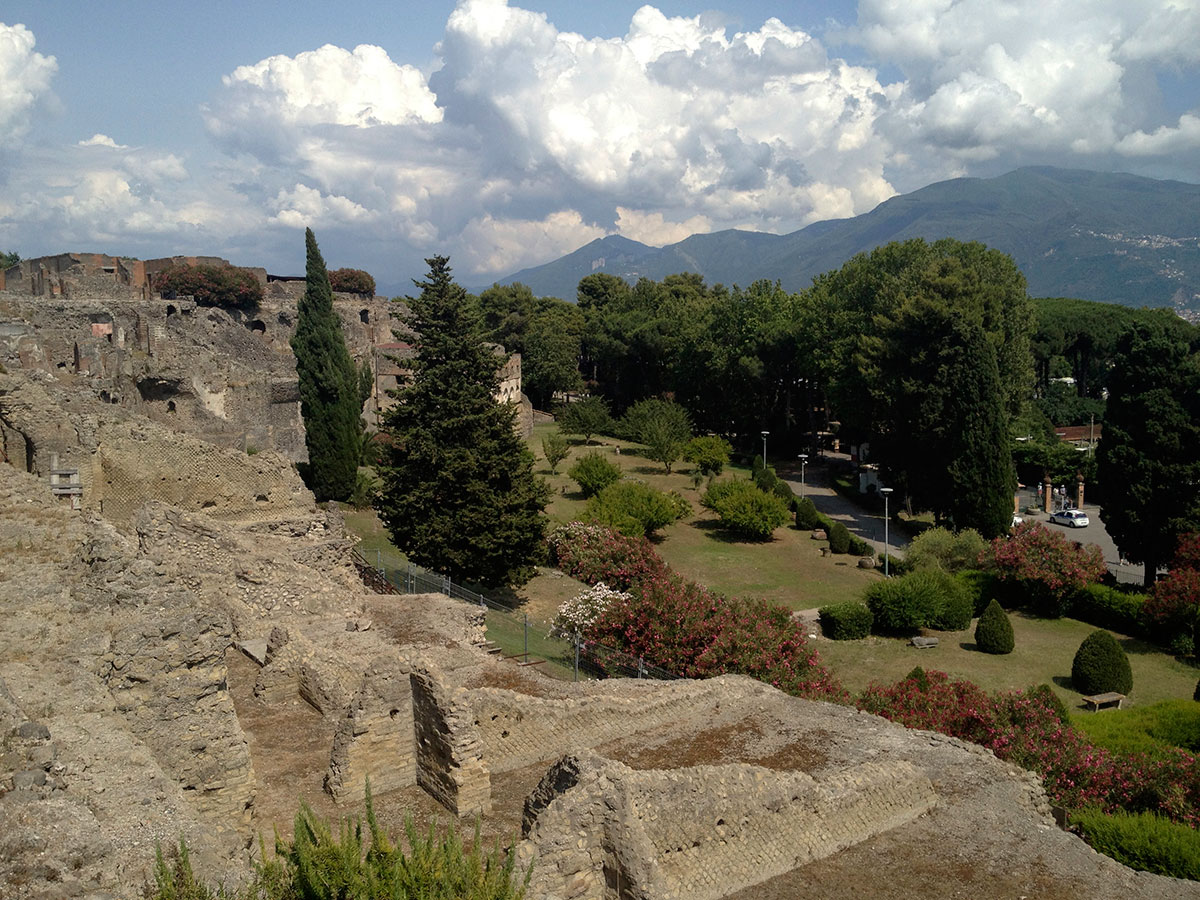
A view from the city towards the southeast. Flowering trees are in bloom, as they likely were on that fateful day.
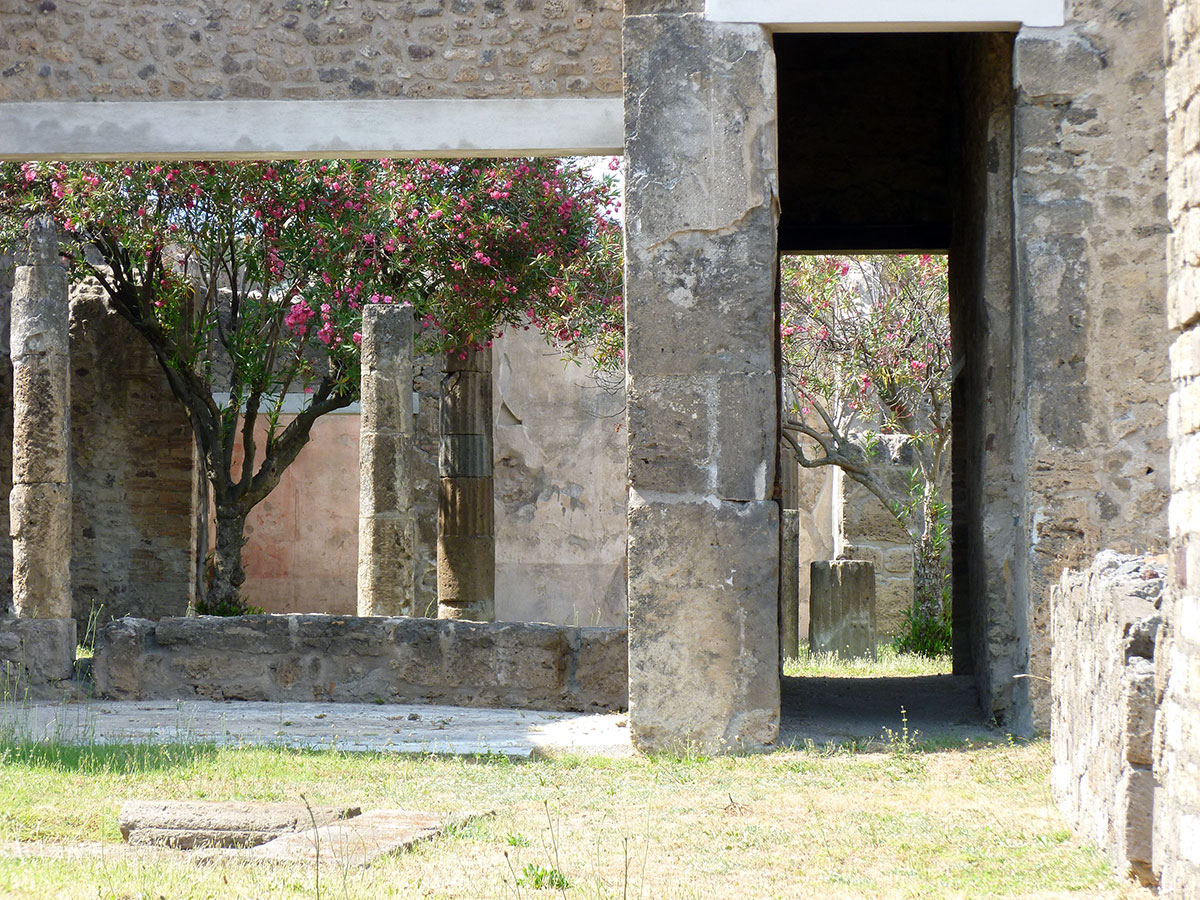
The walls built in Pompeii were built straight and true, and built to last. Trees once again grow in ancient courtyards, silent testament to the relentless power of nature, inexorably working against our puny works in big and small ways.
Tour Overview
Your culinary adventure begins in Naples where you’ll board a motorcoach for a 90-minute ride to a local farmhouse in Sorrento. You’ll visit the “frantoio” or olive mill where the tart orbs are pressed into golden drops of olive oil. You’ll also visit a wine cantina and witness the art of mozzarella-making. Enjoy samples of the fresh white cheese with salami, wine and mineral water.
You’ll return to the motorcoach for a quick 15-minute ride into the town of Sorrento. You’ll have 2 � hours of free time to explore the village overlooking the Bay of Naples and enjoy lunch on your own. Take in the breathtaking cliffside views, enjoy the sea breezes at the Sorrento Pier, go beachcombing along the rocky shoreline or stroll down Corso Italia-Sorrento’s flower-lined main boulevard of shops, designer boutiques and caf�s. Sorrento boasts one of the biggest shopping districts along the Amalfi Coast-from lace sheets and fine furniture, to table linens and handcrafted pottery. It’s a prime place for shoppers and ambiance seekers alike. Get off the main path on to the cobblestone side streets and public squares, such as Piazza Tasso and Piazza Antiche Mura for great atmosphere.
The next leg of your journey continues at Pompeii. Here you’ll discover the archeological excavations of a lost city buried deep beneath the ash when Mt. Vesuvius violently erupted in 79 AD. This monumental natural disaster killed thousands and entombed the city. Explore the grounds on this 105-minute guided tour of the ruins.
Walk the grounds as your knowledgeable guide points out the remarkably preserved remains that hint at daily life-their customs, buildings and cuisine. The eruption of Vesuvius preserved a moment in time more than 2,000 years ago providing evidence of how they entertained, decorated and lived. From the ruins we know Pompeii was a vacation community for high society before the eruption; it had a forum, amphitheater, gymnasium, shops and an aqueduct that delivered water for irrigation, fountains and private baths. Some of the buildings are remarkably preserved with elaborately detailed mosaics and colorful frescoes decorating the interiors of wealthy homeowners’ villas. It’s fascinating and sobering snapshot of ancient Roman life.
Following Pompeii, you’ll re-board the motorcoach and stop at a cameo factory where artisans apply skills handed down for generations, carving seashell or coral into intricate works of art and beautiful keepsake jewelry.
Your tour comes to an end back in Naples after a 30-minute drive where your ship is docked and awaiting your return.
Day 038: Aegean Sea
Day 038: Ionian Sea
Position: N 37º 26′ 17″ E 017º 34′ 09″
Weather: 23ºC wind 15-20kts from the north, waves 2m
Last Port: Istanbul, Turkey
Next Port: Naples, Italy
Status: Underway
From the Navigator
Early this morning we will transit the Elafonisu Strait to round the southern coast of Greece and set westerly courses across the Ionian Sea towards Italy. Early this evening we will round the southernmost point of Italy and at approximately 2030 we will board our Messina pilot and start our transit of the Messina Strait which separates Sicily from Italy. Once clear of the straits we will set north easterly courses up the coast of Italy towards Naples.
Day 037: Anzac Cove, Turkey
Day 037: Anzac Cove
Position: N 37º 54′ 58″ E 24º 34′ 44″
Weather: 31ºC wind 2kts, waves 1m
Last Port: Istanbul, Turkey
Next Port: Naples, Italy
Status: Underway, Anzac Cove
From the Navigator
During the early hours of this morning we will transit the Dardanelli Strait and once clear we will set northerly courses towards ANZAC Cove. We anticipate being off Anzac Cove at 0600. We will hold position off the coast and when ready to depart this morning we will set south south westerly courses across the Acean Sea. This evening we will pass the islands of Andros and Kea on our port side as we make our way south past the Greek mainland.

The ship is based in Australia. Many of the passengers are from Australia and New Zealand. So we held a moving service as we drifted in Anzac Cove. Ed has been singing with the onboard choir and participated in that capacity.
Day 036: Istanbul, Turkey
Day 036: Istanbul, Turkey
Position: N 37º 58′ 32″ E 023º 43′ 26″
Weather: 36ºC wind north east 10 kts
Last Port: Mytilene, Greece
Next Port: Naples, Italy
Status: In port, starboard-side-to
From the Navigator

We are suckers for ferries. We love intermodal transportation, and as the gateway city between Europe and Asia, Istanbul has embraced intermodalism with an aggressive but practical intensity. Water taxis are almost as abundant as auto taxis, better maintained and cheaper by the mile.

Our advice if you arrive at Instanbul by sea and in the morning – get up early to watch the transit. The morning sun illuminates the famous sites with a striking low light. These same sights in the afternoon will appear as mere silhouettes with a powerful backlight. Get up early and keep looking west! You can identify this as the Blue Mosque by the six minarets. The greater the number, the greater the patron who had it built.

Inside the Blue Mosque. It is “blue” because of the ornate blue tile. We were told there could be no images of people or animals because Allah (God) is the creator and therefore the only one who can produce such images perfectly. We mere humans must remain humble and stick to the written word, geometric and floral patterns.

A closer view of the main dome. There are four semi-domes facing the main compass points, each with three even smaller semi-domes. The result is an immense space supported by only four massive columns to support the main dome.

Next we visited a local craft center specializing in authentic hand knotted rugs. Each rug takes a minimum of one month and the time increased based on size, thread count and complexity of the design. The size alone does not determine the price. Rather, it is the time. Large Turkish rugs can take over a year of work by two skilled craftspeople. This lady worked while the presenter talked about the process, patterns and offered us drinks.

Here she continues transferring the design (above) into colored knots. The tufts are shorn across to leave a perfectly uniform surface of either wool, cotton, silk, or any blend of these. The figures in the rugs can tell a story of the events in the life of the weaver at the time: a birth, harvest or other major life event.

Close up of the pattern. The detail and colors are intricate. The knotwork itself is not complicated, but detail work takes time.

The finished product, this one in wool. We liked it the best after seeing over two dozen designs in various sizes. The price: $1,200 US shipped to our doorstep. Sadly, not this trip!

You want Turkish delight? You got Turkish delight! All shades, sizes, flavors, prices. Boxed to take home with you. You want a bag for that?

In the Grand Bazaar, you can pretty much find anything you want. Tens of dozens of shops of whatever it is you want. Spices? Yes, we have those. If you can make your way through the air thick with the intermingling scents.

Here’s Daniel, who grew up in Turkey and Seattle, USA. He’s started his own business and wants to turn it into a chain throughout Turkey. He says it’s easier to start a business here than in the U.S. because they have fewer regulatory restrictions and want to encourage business. We wish him well!

Ah, the sweet desserts of travel. We hope you’re enjoying the journey with us. Let us know in the comments here, or on our Facebook page. And please SHARE this adventure with your friends!
Tour Overview
A scenic 25-minute drive in your motorcoach takes you across the Galata Bridge into the heart of Istanbul, the largest city in Turkey and the capital of the Ottoman Empire.
Your first destination is the Blue Mosque, also known as The Sultan Ahmed Mosque. This 17th-century marvel was built to rival and surpass the grandeur and beauty of nearby Hagia Sophia, and is a true study in color. It displays a multitude of domes and semi-domes and graceful minarets on the exterior, and over 20,000 shimmering blue Iznik tiles in more than 50 different tulip designs, and 216 stained glass windows, on the interior.
Just a short walk away, Hagia Sophia comes into view. Also known as St. Sophia, the Church of Holy Wisdom, it was originally built by Constantine the Great, and later rebuilt by Emperor Justinian to be a “queen church” of the new empire. Considered one of the greatest surviving examples of Byzantine architecture, it’s rich with mosaics and marble pillars and coverings.
Nearby, the Byzantine Hippodrome presents an opportunity to snap a photo or two as you walk by this imposing arena, once the heart of Constantinople’s political and sporting life, and the scene of games through the history of the Byzantine empire.
After an awe-inspiring exploration of Turkish history, you’ll board your motorcoach for a “shop ’til you drop” experience at the Grand Bazaar. Start off with a carpet demonstration, then enjoy three hours on your own to explore. With over 4.000 shops filled with jewelry, carpets, leather ware, and copper goods, you’re sure to find something that will strike your fancy. Bargaining is expected and half the fun.
Your tour concludes with a walk back to your motorcoach, and a relaxing drive back to the port. With Istanbul behind you, you leave with a myriad of unforgettable memories of a lifetime.
Day 035: Mytilene, Greece
Day 035: Mytilene, Greece
Position: N 41º 01′ 53″ E 028º 59′ 22″
Weather: 32ºC northeast wind 10kts
Last Port: Athens, Greece
Next Port: Istanbul, Turkey
Status: at anchor, taking tender boats to shore
From the Navigator
We will maintain north easterly course throughout the early hours as we cross the Aegean Sea and approach the Island of Lesvos. At 0700 we will ring standby on our engines and make our approach to our anchorage position. We anticipate being at anchor by 0800.
Once we have all our tenders back onboard we will weigh anchor and set various north westerly courses around the top ef Lesvos and the northerly course passing between the Islands of Limnos on our port side and Gokcedada on our starboard side as we make our way towards the Dardanelles. Later tonight we will start our transit of the Dardanelles with the aid of a pilot as we make our way into the Sea of Marmara.
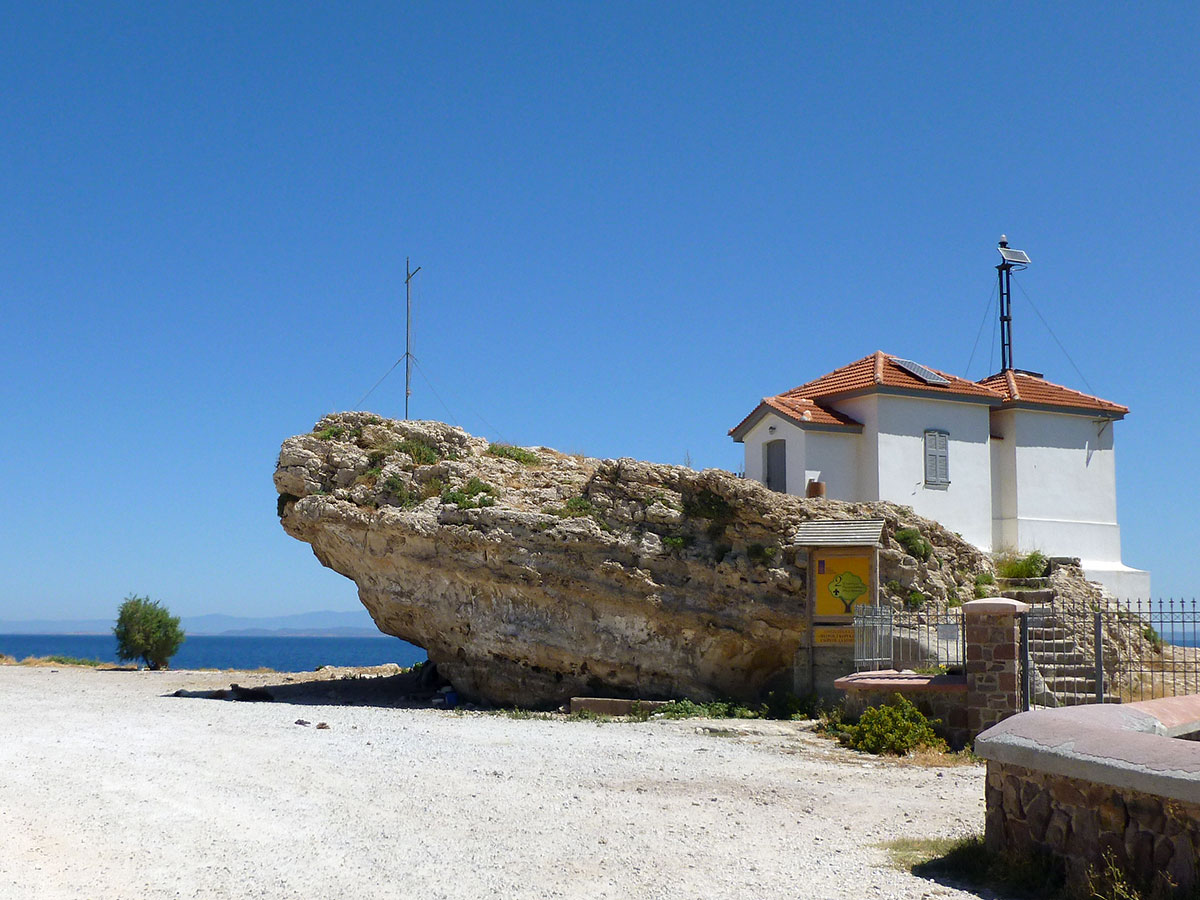
The Hellenic Lighthouse Association maintains a light on this eastern point of the island. Kids – what does this look like to you?
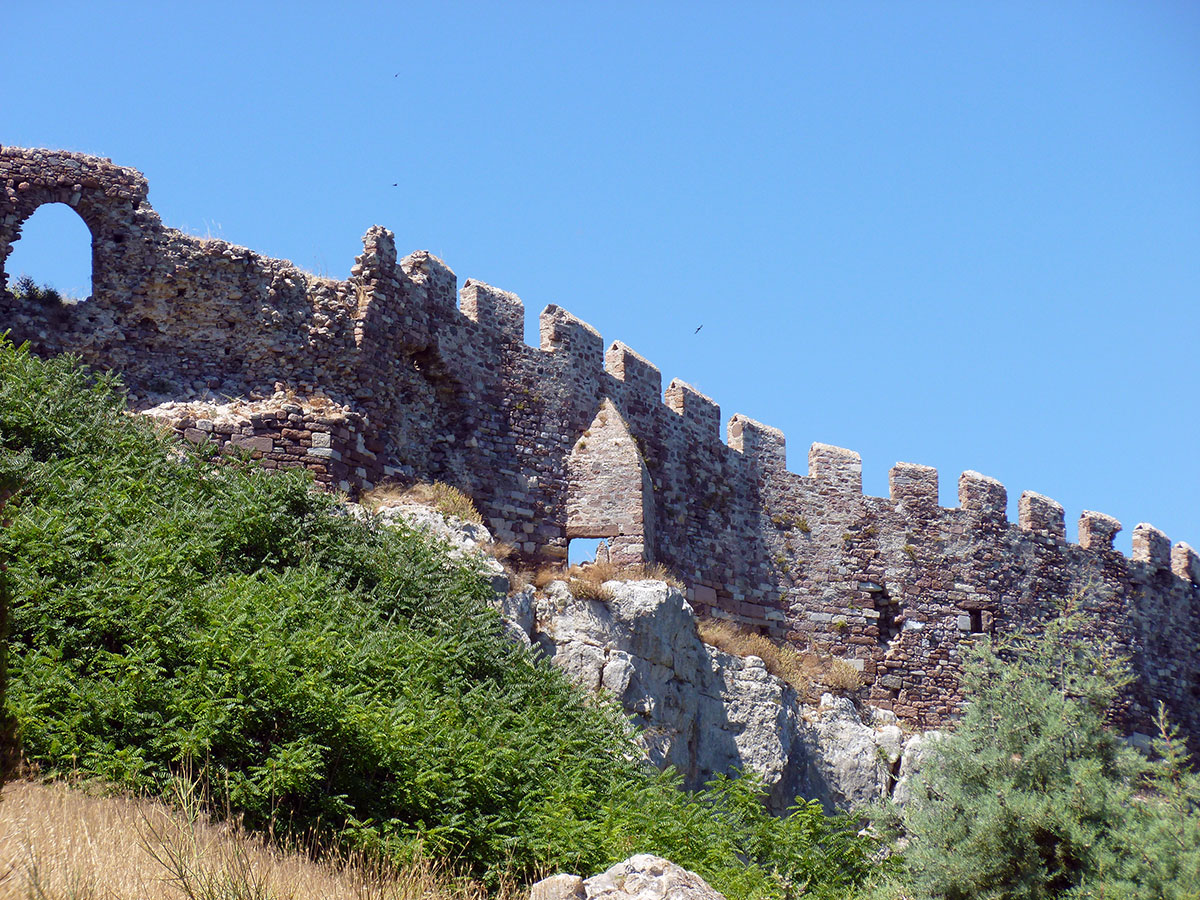
A fortress protecting the harbor. It was built in stages and now, it’s being repaired. In stages. The recent economic problems in Greece have slowed down many things, including this project.

There was no activity on the site, probably because we visited on a Sunday. There were no barriers, signs, security or OSHA to keep us out. We wandered all around the restoration area. This kiln looked to be for firing clay pots and items. It would not surprise us if they put it back into use once the rebuild is complete.
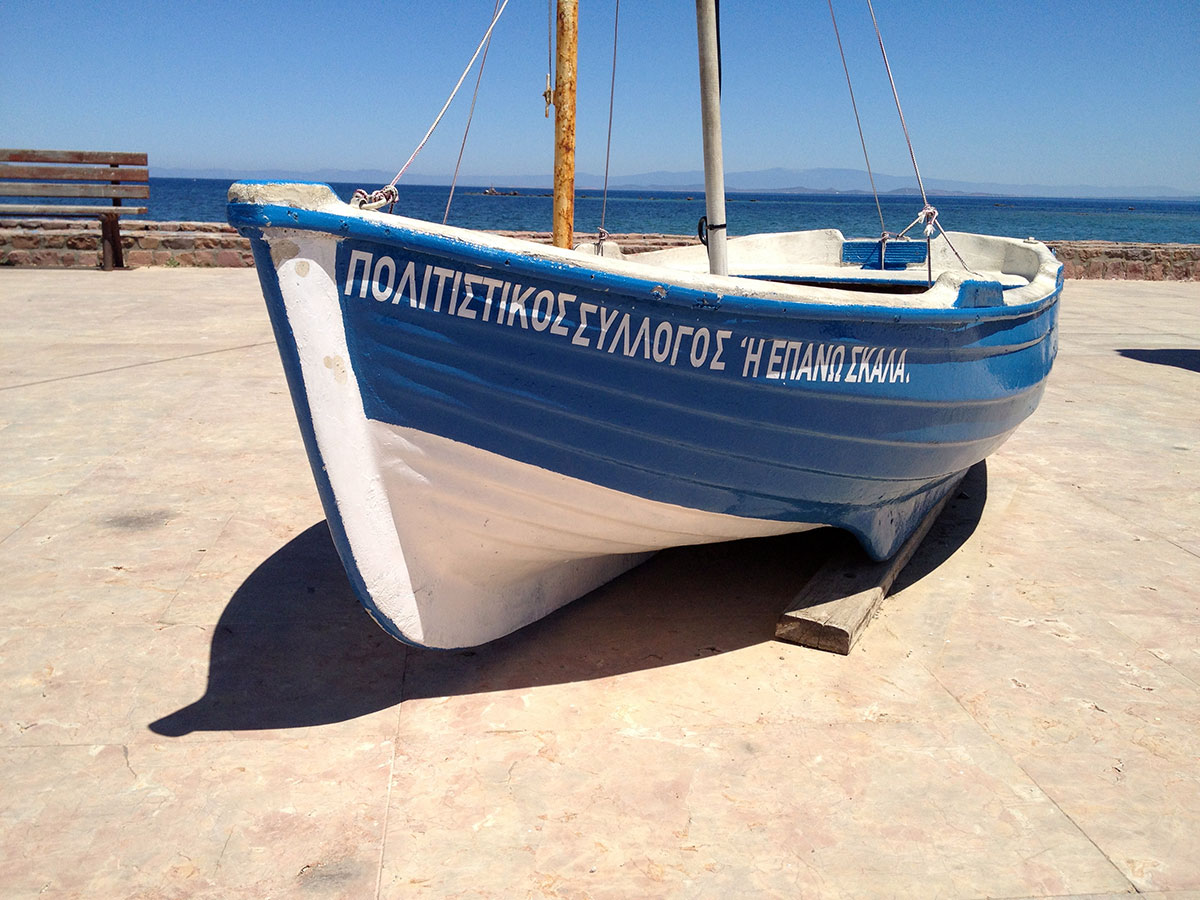
Now this is a sailboat to write home about. Notice the short centerboard but wide outriggers built into the hull. Perfect for sailing, rowing, and dragging ashore on shallow secluded island beaches.
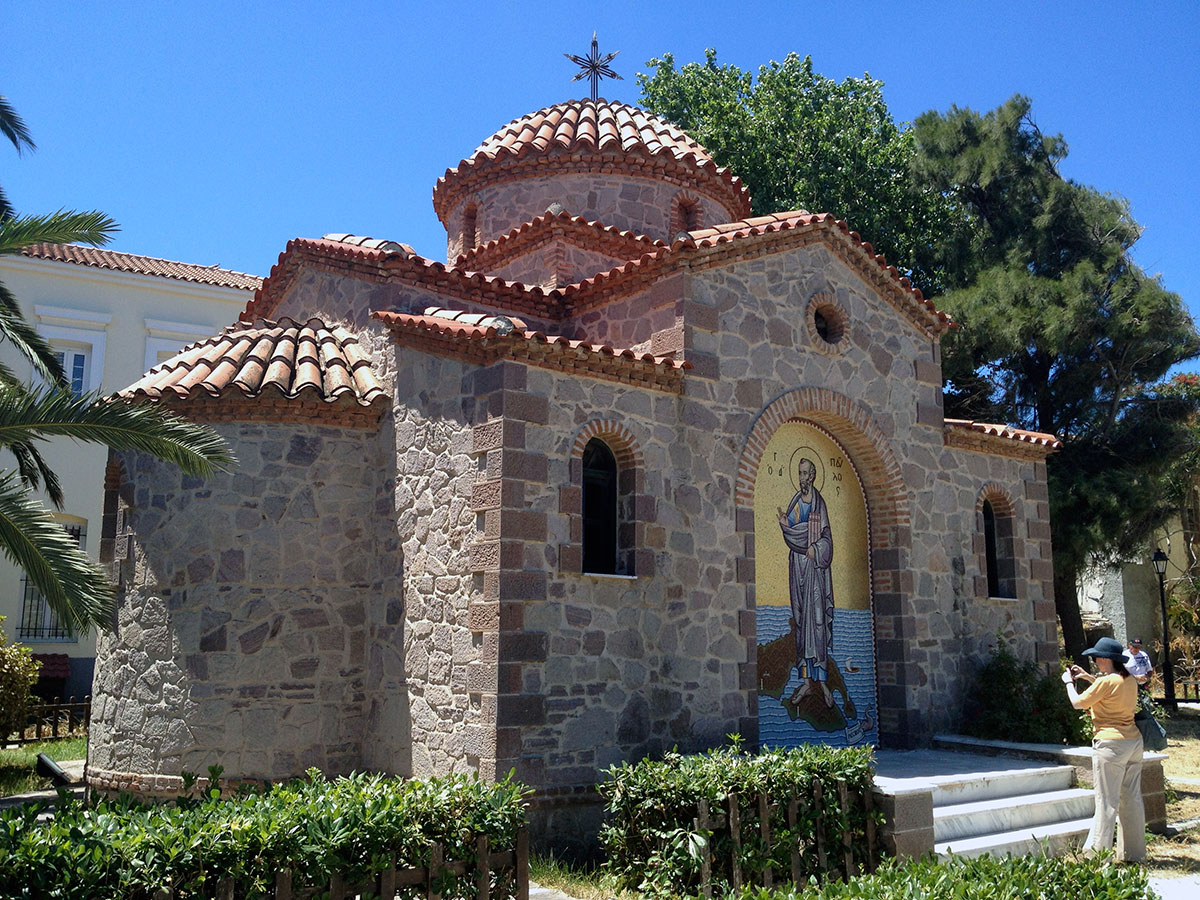
An impressively restored Greek Orthodox church. The stones appeared newly cut and fresh, the marble steps aligned tightly with each other, the colors complementing the site’s tasteful landscaping. On second thought, maybe this in no a restoration, but new construction. Beautiful to behold and especially the mosaic on the northeast side. Being Sunday, the chapel was closed.

Our first shots through the windows gave us nothing but a white flash flare. So we tried again, this time with iPhone and flash turned off. This composite picture is the result. Lesson learned here – keep trying. You may be surprised what your technology can capture for you.

In the cool down period before lunch. We wandered into a cafe and sat by the water. They ignored us for about five minutes, which gave us time to catch our breath, watch the small fish battling the shoreside swells and enjoy the breeze off the water, cooler by more than 5ºC. Then we ordered coke and ouzo, the local specialty alcohol. This brand is named after the island, and while the label is obscured in this picture, quite potent at 92 proof. Yes, 92.
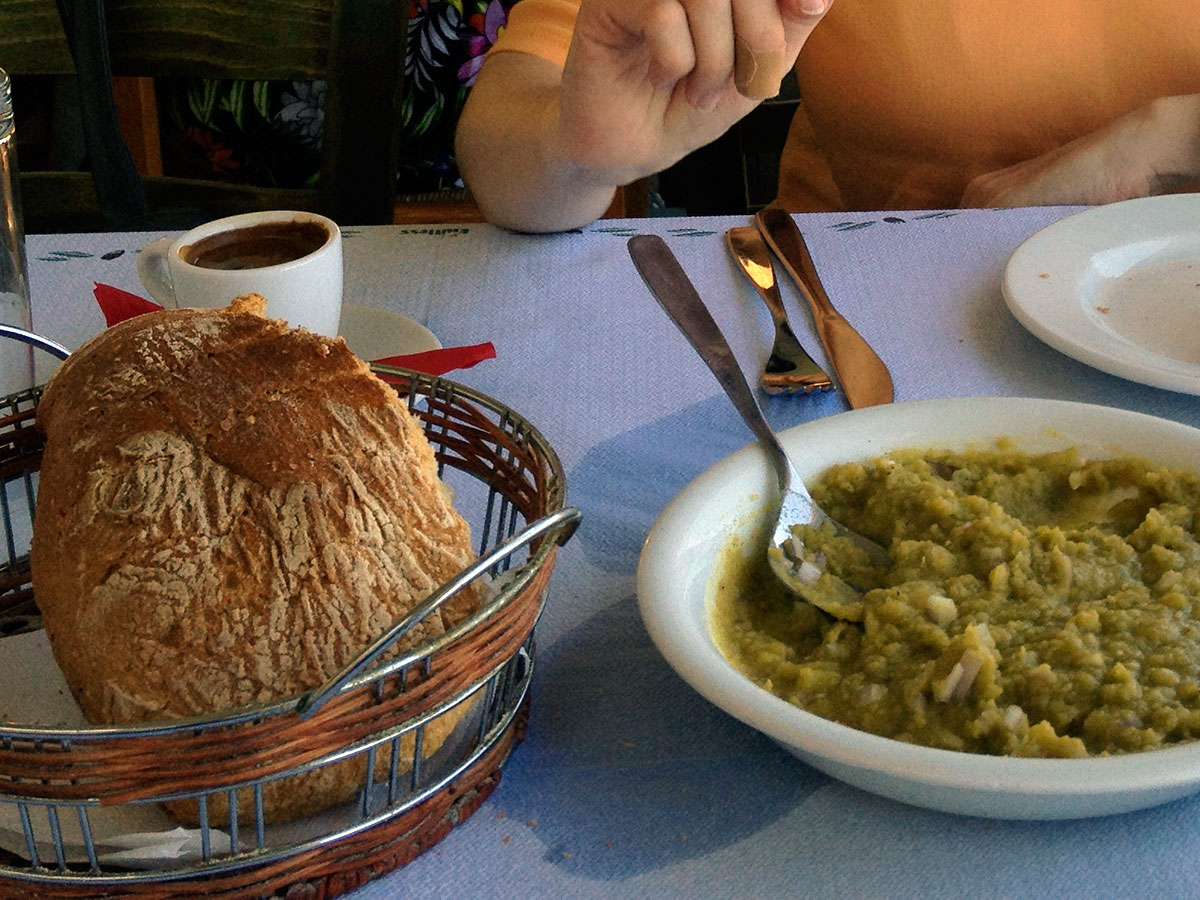
Michelle ordered the hava bean dip. It arrived topped with chopped purple onion, which added just the right savory flavor to an already well seasoned mash. The bread was fresh baked and exactly the way we like – thin crusty on the outside with a nice sprinkle of dry flour and meal, and warmly soft and moist on the inside with a hint of residual yeast in pockets of un-uniform texture to offset the earthiness of the dark grain flour. And of course the Greek Coffee, sweetened “medium”. We’d hate to taste what “sweet” might be, the cuppa was a veritable dessert all by itself.
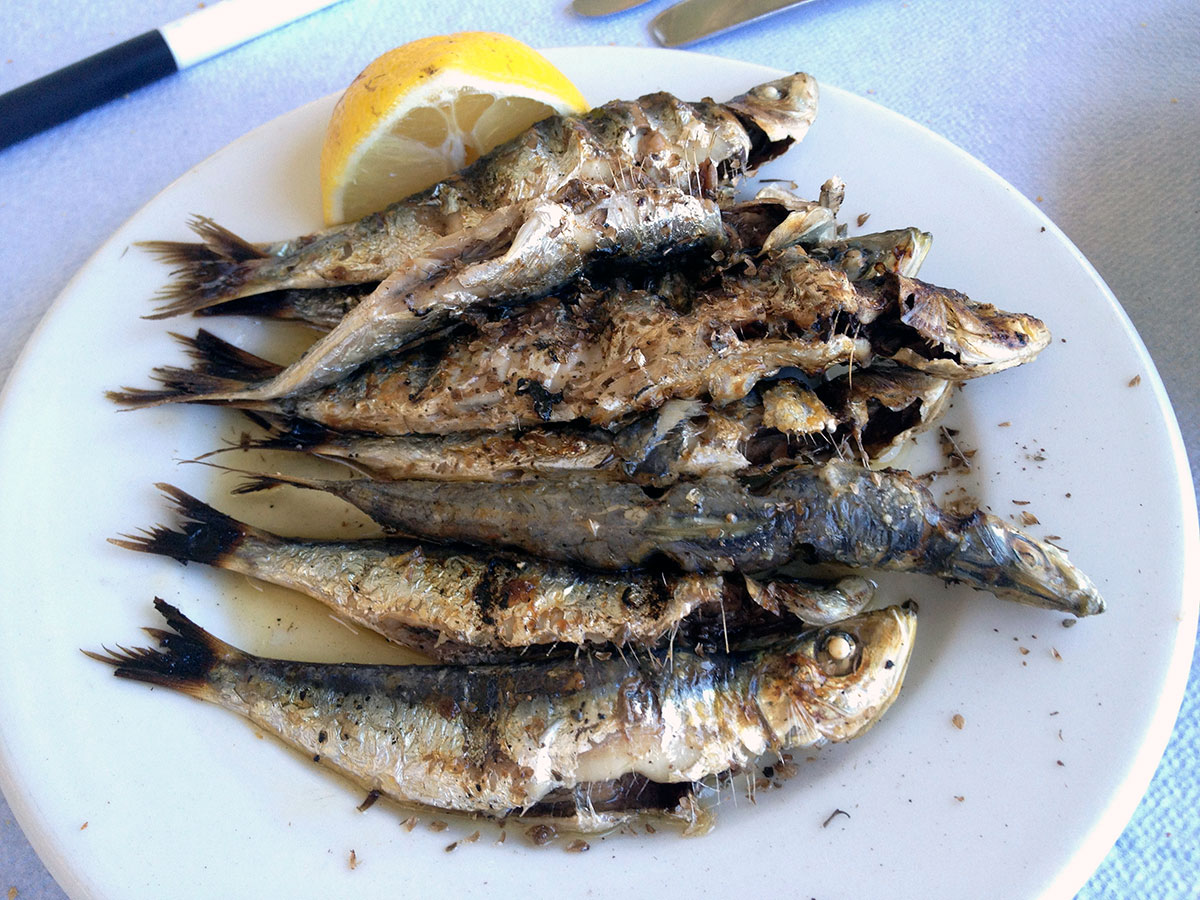
At Michelle’s suggestion, Ed ordered a kilo of grilled sardines. We had very likely been watching their cousins just below our table the whole time. The flavor of freshly caught and grilled sardines will linger with us a long time, just slightly longer than the aroma they left on our fingers.

Ed after a wonderful lunch of fava bean dip, grilled sardines and ouzo. MMMmm. Does this guy look at home or what? Yes we know this does not say “Popeye’s” in Greek. But hey, Popeye was a Coastie.
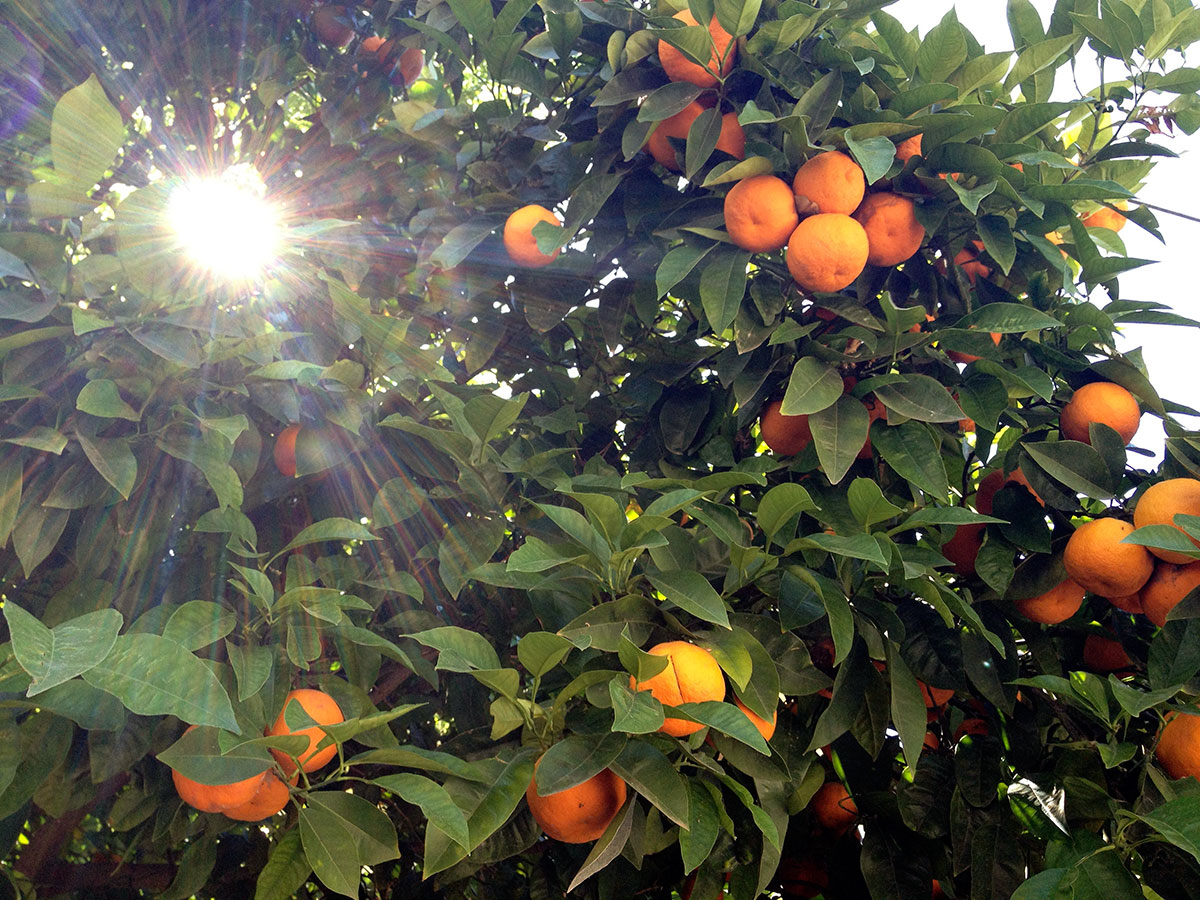
Imagine this tree shadowing your local neighborhood sidewalk. I doubt the fruit would last more than a day. Now imaging an entire city block shaded by trees bearing similar clumps of oranges, four to six in a bunch. And then think juice, fresh squeezed by hand into small glasses. Every morning for breakfast. You’d live forever.
Day 034: Athens, Greece
Day 034: Athens, Greece
Position: N 37º 58′ 32″ E 023º 43′ 26″
Weather: 36ºC wind north 15 kts
Last Port: Ashdod, Israel
Next Port: Mytilene, Greece
Status: In port, port-side-to
From the Navigator

Columns in various states of repair. It was an absolutely clear and blue day. The wind was relentless, pounding in from the north and stirring up dust, sand and grit. Millions of footsteps have polished any piece of exposed marble to a fine polish. The slippery footing combined with the fine dust, uneven terrain and blowing debris made walking tricky.

Here we are after taking a few minutes to photograph our backpacking passengers – the West By Sea object collection

This may look like a jumbled pile of rocks, a child’s building block collection. But look again. Those three vertical windows are perfectly square, exactly the same in dimensions. Look a third time. The horizontal space *separating* the windows is exactly the dimension of the windows themselves. Now try doing that with technology only available 3000 years ago. Yup. Hard.

Another temple at the Acropolis. (We will dig out the name in the updated version of the post. Who knows what these columns represent?)
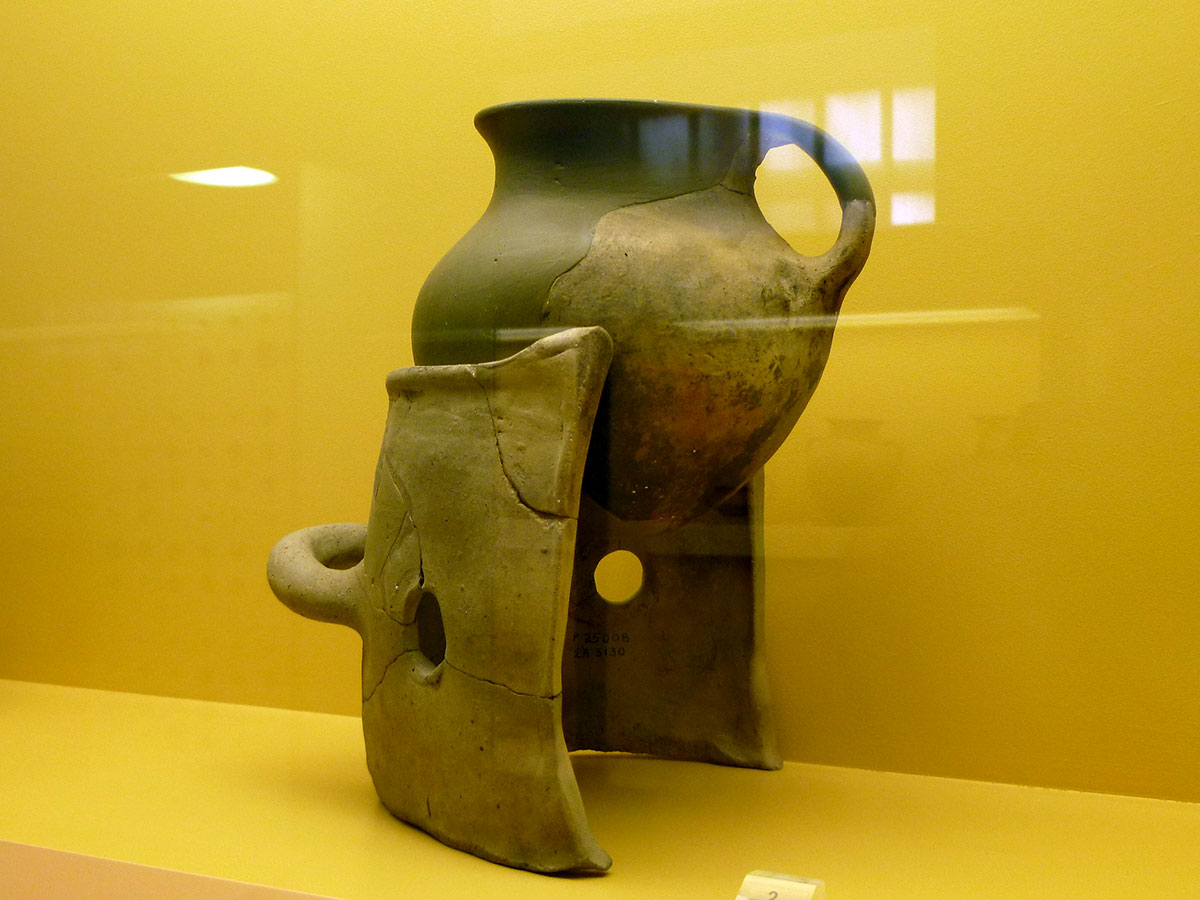
The modern camping industry could take a hint from this Hellenic period cookware. I love that the heat shield has its own matching handle.
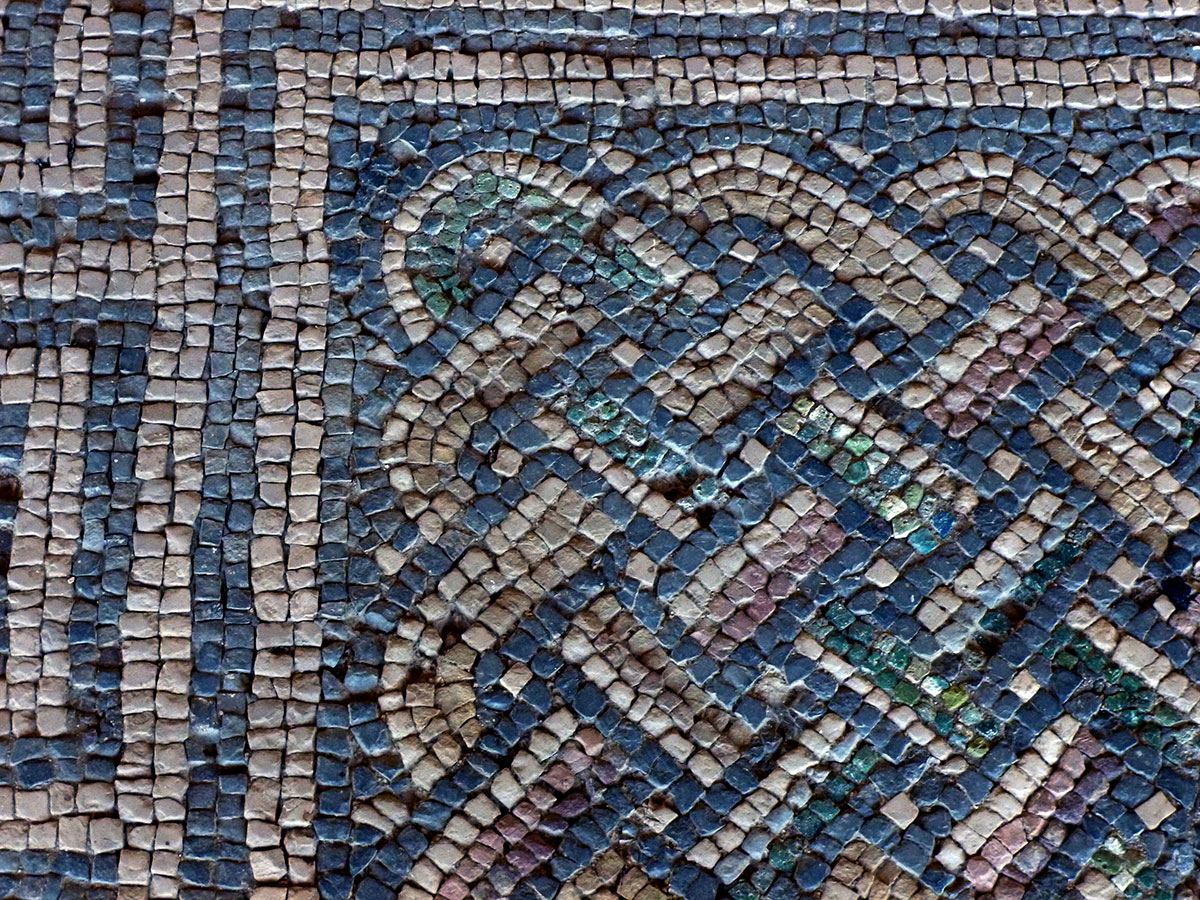
This pattern was on the ground. It looked absolutely drab, the colors barely visible. Through the magic of photoshop we can see the effect produced by thousands of irregular tiles, each smaller than one centimeter square. Placing this floor required dedication and attention to detail. And maybe a little ouzo?

The Temple of the Eight Winds. This was an early observatory, with sighting slots, sundial and a water clock for keeping time on cloudy days.
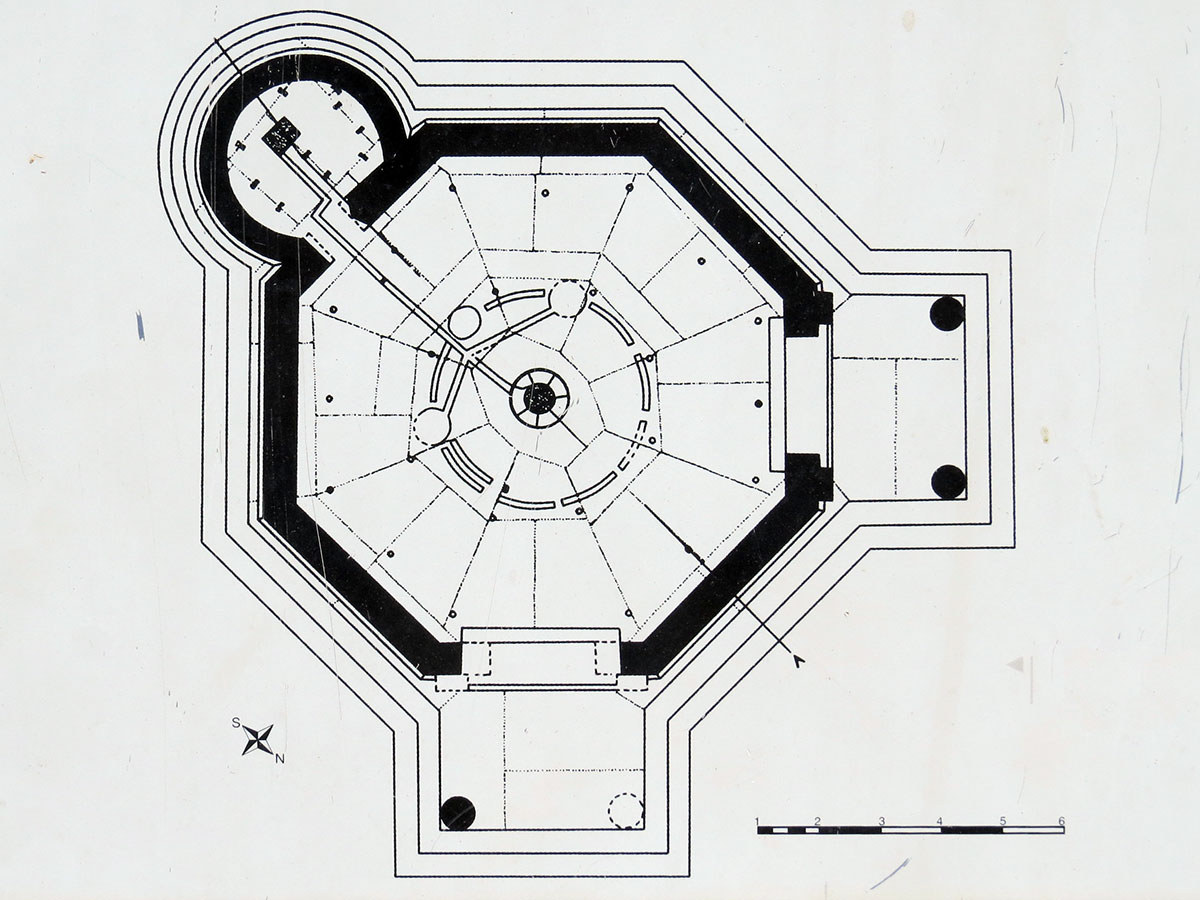
For Ed and you engineers out there, this is the best part – the plan view! It is rare to find something like this, but a welcome addition. We thank the designers of this sign for including a scale with the layout. This means we can build one of our own some day.
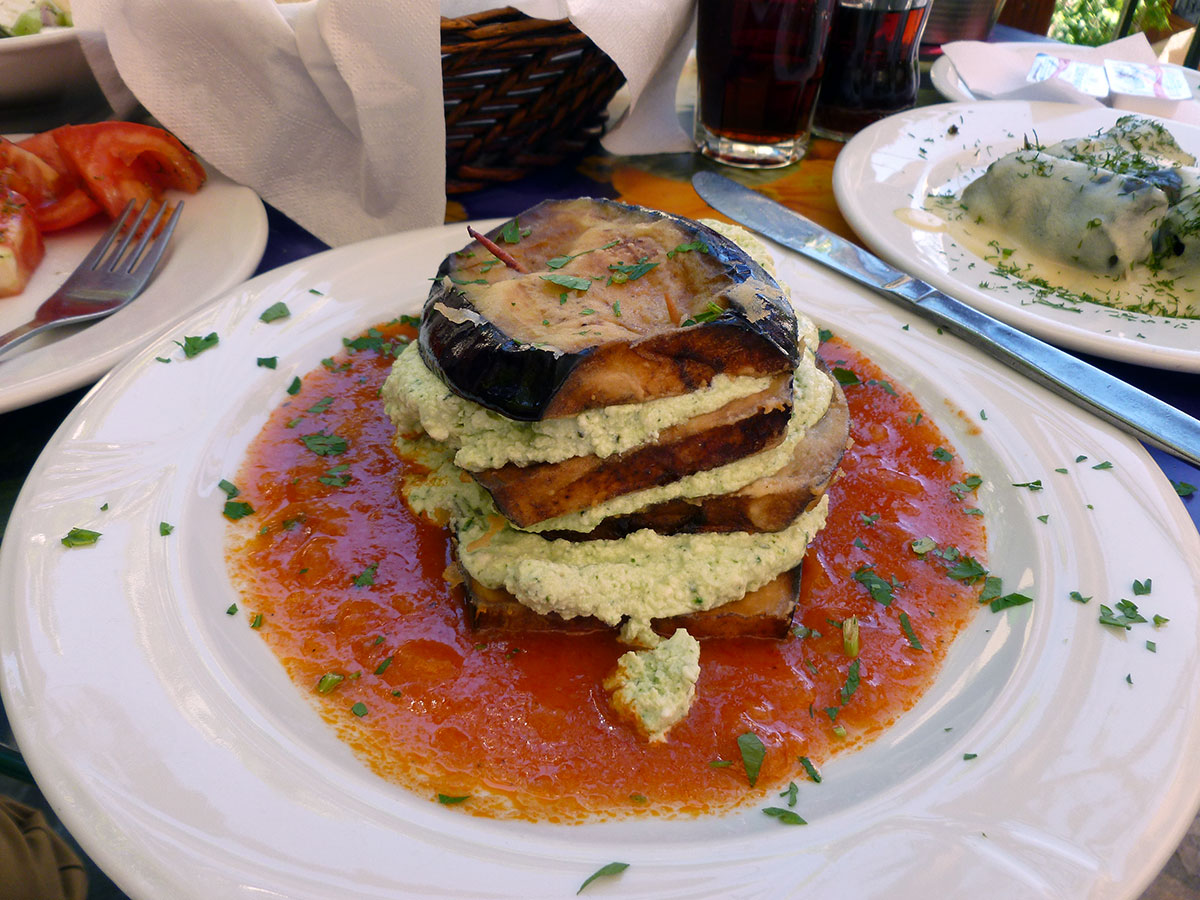
Michelle ordered this eggplant lasagne, alternately stacked with thick slabs of the vegetable and a filling which contained a more than generous proportion of pesto. The grape leaves are stuffed with a mixture of ground lamb, rice, mint and spices and drizzled with a lightly creamy cheese sauce.
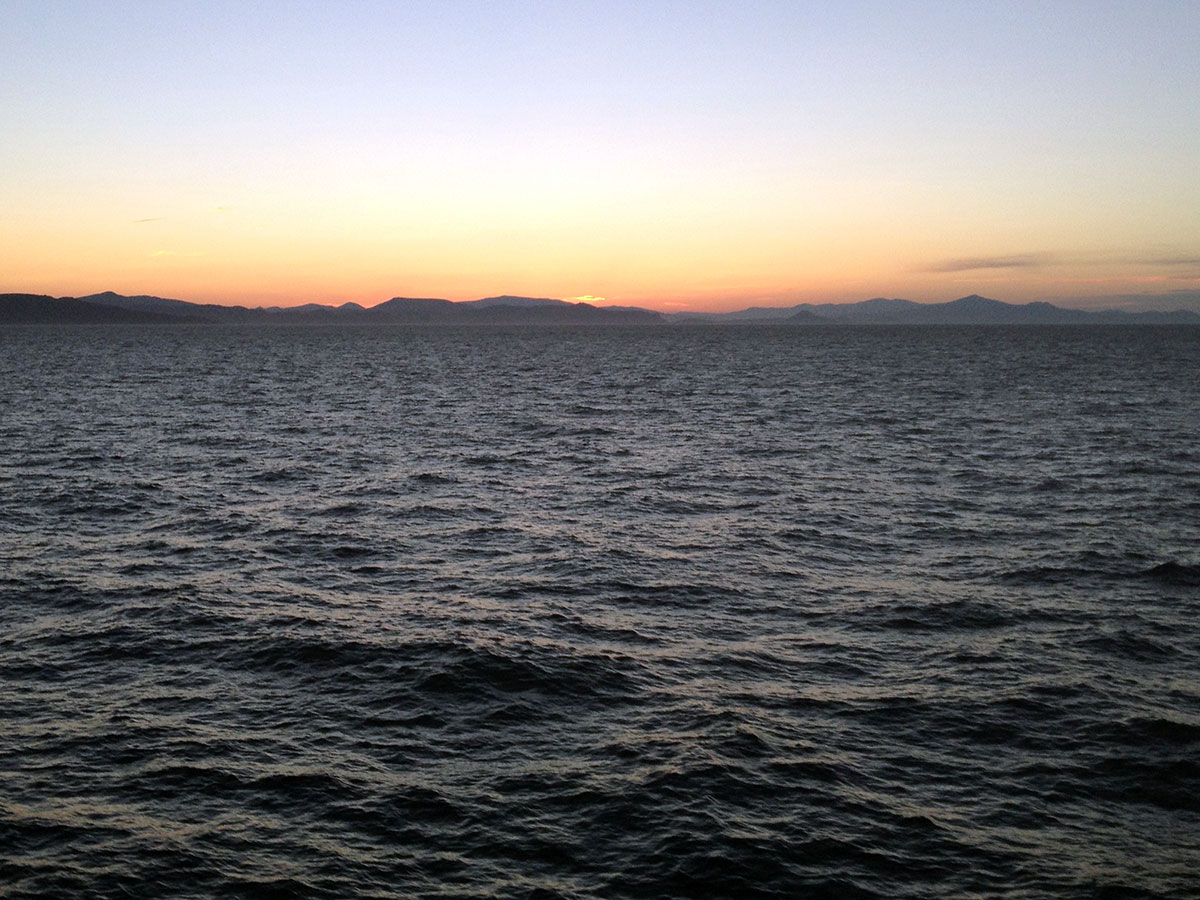
Back underway among the islands of Greece. It is easy to understand why they became a seafaring people. The islands are all visible from each other, just a short journey by boat. You don’t need a reason. Just go.
Tour Overview
Board your motorcoach for a scenic driving tour into the heart of Athens. Your narrated tour orients you to the city and passes a host of major sites, including Hadrian’s Arch, the statue of Lord Byron, the Temple of Olympian Zeus, Constitution Square, the former Royal Palace, the National Gardens, the Academy and the University Library.
Your six-hour, independent exploration begins in central Athens as you will be dropped off near the traditional shopping district of the Plaka.
The metro station is located at Syntagna Sauare (Constitution) and is probably the most beautiful station you will ever see, with an underground archeological museum right next to the trains. Across the street are the National Gardens, where you can hop a trolley bus to the National Archaeological Museum, unless you’d prefer to take a pleasant 30-minute walk there.
A short walk away is the Plaka, the city’s historic shopping district, located just under the Acropolis. The Plaka is the oldest section of Athens. Most of its streets have been closed to automobile traffic and walking the cobblestone pedestrian lanes will make you feel as though you have been transported to a small village. The streets are lined with boutiques, souvenir stands, jewelry stores, and colorful flea market stalls. Street musicians entertain as you browse the shops and flower peddlers offer fragrant bouquets as you pass by.
When you’ve worked up an appetite you can choose from a myriad of caf�s and tavernas offering traditional Greek fare. The seafood is exceptional, the salads fresh and flavorful, and the house wines a delight. Take a seat at an outdoor caf� and savor Greek coffee and traditional pastries, a wonderful way to soak up the local color and relaxed tempo.
Discover the many small museums in Plaka, including the beautiful collections in the Museum of Greek Folk Art, the charming Greek Musical Instrument Museum, and the Jewish Museum of Greece.
At the completion of your independent tour, return to the designated motorcoach area and meet your fellow travelers for a return trip back to port.
Day 033: Mediterranean Sea
Day 033: Mediterranean Sea
Day 032: Jerusalem / Bethlehem, Israel
Day 032: Masada and the Dead Sea (Jerusalem / Bethlehem, Israel)
Position: N 31º 35′ 26″ E 035º 24′ 22″
Weather: 30ºC wind northwest 8 kts
Last Port: Aqaba, Jordan
Next Port: Athens, Greece
Status: in port, Ashdod, Israel
From the Navigator
This morning we will commence our final approach to Ashdod at approximately 0430 and expect to board our local pilot at 0445. Once the pilot is onboard we will proceed in through the breakwater before swinging and backing down alongside our berth. We plan on being alongside at 0545. Once everyone is back onboard this evening we will let go our lines, thrust off the berth and retrace our courses out of the harbor. Once clear of the breakwater we will disembark our pilot and set north westerly courses across the Mediterranean.
Audio brief for the port (28mb .mp3)
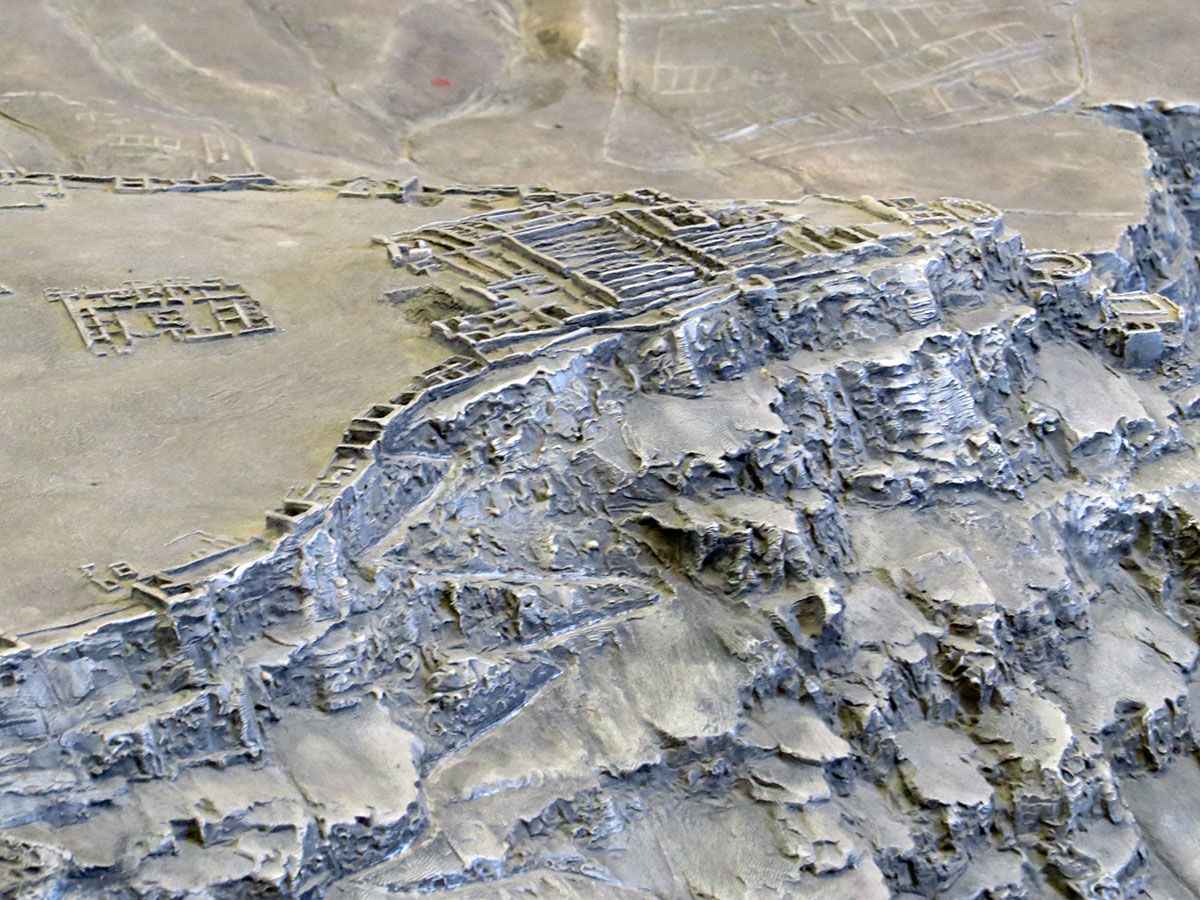
Masada was the fortress of King Herod. A small group of Jewish rebels withstood a siege here before committing mass suicide. Check www.masada.org.il for the official information about the site.

One of the many bath sinks at the bathhouse in the palace. Outside now, but once covered. Such luxury from over 2000 years ago.
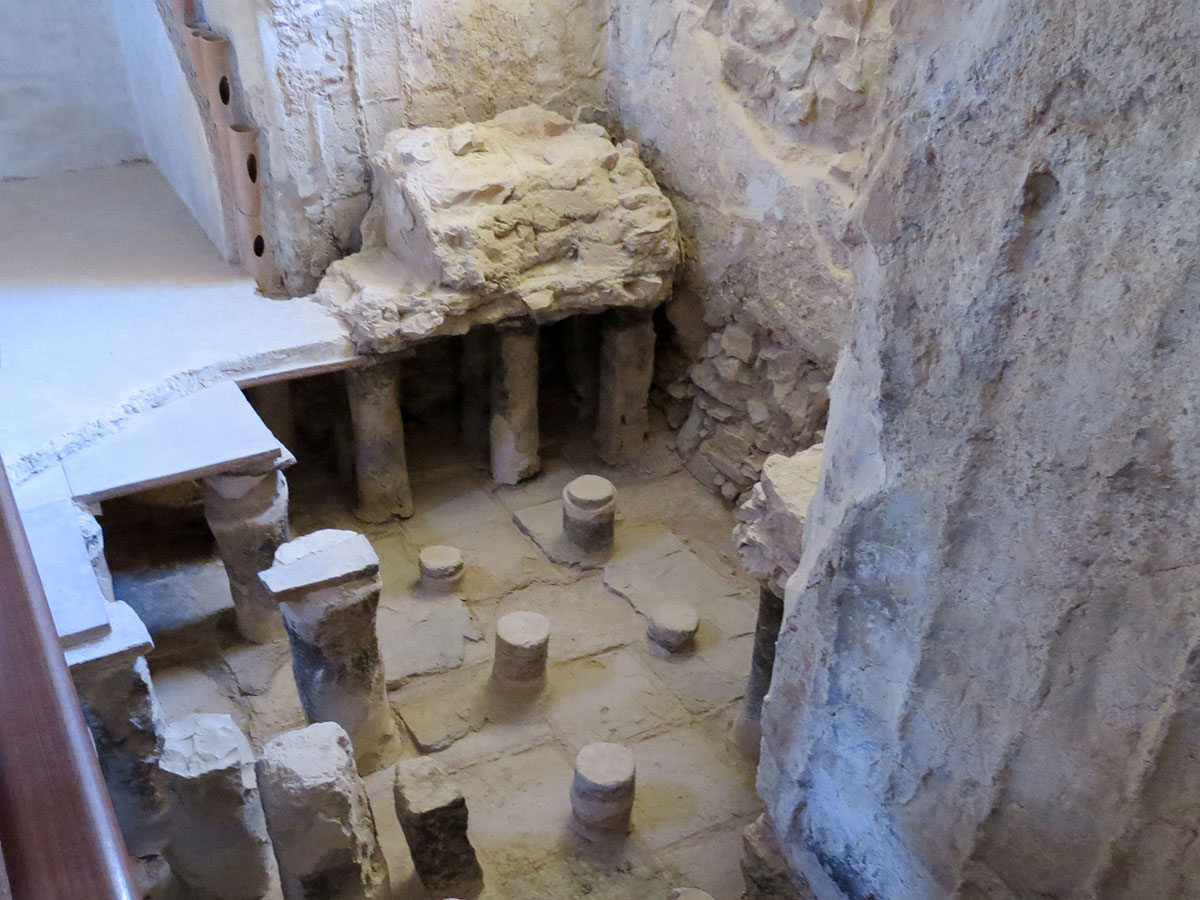
The underside of the steam room. The water was heated below and piped in. Then the steam would rise through the vertical pipes and escape through holes (visible at the top of the picture).

The Dead Sea from a vantage point at about sea level. The water level is around 1300 feet below sea level. The country of Jordan is visible across the Sea.

Heading back to the ship, and obligatory Israeli traffic. There is a lot of construction and dust, but also plenty of tree plantings.
Tour Overview
Set forth on this amazing and rigorous full-day tour by meeting your professional guide at the pier and boarding an air-conditioned motorcoach. Then sit back and relax as you embark on a two-hour scenic drive from the verdant coastal region of your port city Ashdod through rugged rocky terrain in the Negev Desert.
Visit Masada, the most spectacular ancient archaeological site in Israel! This breathtaking fortress and palace built by Herod the Great around 37 B.C. on a tabletop mountain towers 1,450 feet above the Dead Sea. It was here that for three years Jewish Zealots made their last stand against Roman armies during the Jewish Revolt. With the Romans on the verge of breaching the walls, the Zealots, in a last act of defiance, chose mass suicide in 73 B.C. Ascend this mountaintop fortress by cable car for the opportunity to explore the magnificent ancient ruins of this moving site, which include Herod’s three-tiered palace, the synagogue, the baths, the defending walls, and the water cisterns that are an engineering feat still today.
Continue your journey through the desert to the Dead Sea, the lowest place on Earth at 1,276 feet below sea level. As its name evokes, the Dead Sea is devoid of life due to an extremely high content of minerals which give its waters the renowned curative and therapeutic qualities recognized since the days of Herod the Great, more than 2,000 years ago.
Stop at a leading hotel situated on the shores of the Dead Sea to enjoy a delicious lunch buffet accompanied by wine. Then slip into the warm, sea waters to experience firsthand the exquisite sensation of floating effortlessly upon the waters so filled with salt that even non-swimmers can remain buoyant without even trying.
As you embark on your return journey along the shores of the Dead Sea, you will pass the ruins of the ancient settlement of Qumran where, in 1947, a Bedouin shepherd boy discovered the Dead Sea Scrolls, a collection of 972 documents, including texts from the Hebrew Bible.
Day 031: Suez Canal
Day 031: Suez Canal, south to north
Position: N 30º 28′ 52″ E 032º 20′ 40″
Weather: 31ºC wind north 15 kts, canal is calm
Last Port: Aqaba, Jordan
Next Port: Ashdod, Israel
Status: underway, northbound in the Suez Canal
From the Navigator
At approximately 0330 we will approach our anchorage waiting area and shortly after drop anchor to await our local officials and the start of the convoy. Just before 0700 this morning we will weigh anchor and join our convoy as we commence our transit of the canal. We anticipate passing through the great Bitter Lake at around 1030 this morning and at around 1430 this afternoon we will pass under the Suez Bridge. At around 1530 we will pass the El Ferdan Railway Bridge and expect to be clear of the canal around 1800. Once clear we will set easterly courses towards Ashdod.
The Suez Canal
Even in ancient times, people dreamed of a water passage between the Mediterranean and the Red Sea.
The Isthmus of Suez is less than 100 miles of open desert, but even this was a formidable task for workers with shovels. There may have been an ancient canal from one branch of the Nile eastward to the Red Sea, but the Suez route was never more than an idea until the 19th century. Napoleon’s expedition to Egypt in 1798 raised the possibility of a canal once again, since it would shorten the route to India, and open a vast French empire in the East. But Napoleon’s occupation of Egypt was short, and nothing was done. The French public, however, had become enchanted with the idea, and a workable plan was finally submitted a half-century later.
Engineer Ferdinand de Lesseps had the good fortune to be a personal friend of Said Pasha, the Khedive (viceroy) of Egypt. Technically, Egypt was still part of the Ottoman Empire, but the Turkish Sultan had very little influence any more. De Lesseps received permission in 1854 to found the International Suez Canal Company, and to dig a canal from the Mediterranean coast to the town of Suez on the Red Sea. He would take advantage of several depressions in the desert, which became the Bitter Lakes. The port of entry for the new canal would be named Port Said, after the Khedive.
The formal opening of the Canal was celebrated in November 1869. The first ship to pass through was the Aigle, carrying the Empress Eugenie of France. A long procession of 68 ships from many nations followed, with much fanfare. The Canal rapidly become a commercial triumph, and the Canal Company grew wealthy. Khedive Ismail, however, fell on bad times because of huge debts.
The Canal was defended during both World Wars, but continued feuding over the Canal Company let to the Suez crisis of 1956, when troops from Britain, France and Israel attacked Egypt. The Eisenhower administration negotiated their withdrawal, with the help of the U.N. The Canal was closed between the two Arab-Israeli wars of 1967 and 1973. The canal was blocked by mines, trapped ships, and artillery fire. It was not until Henry Kissinger worked out a truce that the Canal was cleared and re-opened with the help from the United States.
Since that time, the Canal has again resumed operations with gusto, and substantial improvements have followed. The main channel has been widened and deepened, with several bypasses added. Now traffic can proceed in both directions, without requiring one ship to tie up while the other passes alongside.
The Suez Canal continues to be one of the busiest shipping routes on the globe, and a marvel of modern engineering.



